- Share full article
Advertisement
Supported by

Travel’s Theme for 2022? ‘Go Big’
With Omicron cases ebbing, the industry is looking for a significant rebound in spring and summer. Here’s what to expect, in the air, at the rental car counter and beyond.

By The New York Times
As governments across the world loosen coronavirus restrictions and shift their approach to accepting Covid-19 as a manageable part of everyday life, the travel industry is growing hopeful that this will be the year that travel comes roaring back.
Travel agents and operators have reported a significant increase in bookings in recent weeks for the upcoming spring and summer seasons. The World Travel & Tourism Council (W.T.T.C.), which represents the global travel and tourism industry, projects that travel and tourism in the United States will reach prepandemic levels in 2022, contributing nearly $2 trillion to the U.S. economy. The council also anticipates outbound travel from the United States will increase; it projects bookings over the Easter holiday period to be up by 130 percent over last year.
“Our latest forecast shows the recovery significantly picking up this year as infection rates subside and travelers continue benefiting from the protection offered by the vaccine and boosters,” said Julia Simpson, the president and chief executive officer of the W.T.T.C. “As travel restrictions ease and consumer confidence returns, we expect a welcome release of pent-up travel and demand.”
While uncertainty remains over the course of the pandemic and government policies on mask mandates and testing requirements for travel, the industry is seeing a strong desire among travelers to take big bucket list trips this year, particularly to far-flung international destinations and European cities.
“Travel is no longer just about ‘going somewhere,’” said Christie Hudson, a senior public relations manager for Expedia. “Coming out of such a long period of constraints and limitations, 2022 will be the year we wring every bit of richness and meaning out of our experiences.”
Here are some of the trends you can expect to see.

Air Travel: Fewer restrictions, but for now the masks stay on
Flying in 2022 looks poised to be much like flying in 2021: reminiscent of prepandemic normal at times, infuriating at others. A primary difference is that there will be more people on planes and in airports — 150 percent as many passengers are expected to fly this year as did last year, according to The International Air Transport Association , which represents nearly 300 airlines.
In terms of where you can fly, you’ll have more options than last year. Destinations that have long been closed to most travelers, including Australia, the Philippines and Bali, have started reopening. Airlines have been gradually adding back old routes and expanding with new ones. In the spring, American Airlines, for example, plans to add six new routes from Boston. JetBlue will soon fly direct from New York City’s John F. Kennedy International Airport to Kansas City and Puerto Vallarta, Mexico, among other locations.
You’ll still need to check the latest entry requirements before flying internationally. There are currently more than 100,000 health and travel restrictions in place, according to Meghan Benton , a research director at the Migration Policy Institute, which tracks them. Though that’s around the same number as a year ago, she noted, there has been a move away from quarantines and outright bans of nonessential visitors toward vaccination and testing requirements. Recently, a growing number of destinations, including Britain, have also reconsidered the merits of entry testing.
That flight for a summer getaway could cost less than it did before the pandemic. Fares are down 18 percent from 2019, according to Airlines for America, which represents seven major airlines. In January, the cost of international airfares purchased hit an all-time low since Hopper, a booking app, began tracking them in 2014. Predicting whether, when and where they will rise is harder than it was before the pandemic, however, as new variants, evolving health threats, travel restrictions and pandemic psychology have upended traditional pricing patterns. Fortunately, most airlines are continuing to waive flight change fees on all but basic economy flights, said Brett Snyder, the founder of Cranky Flier , an airline industry site.
When flying in the United States, everyone will need to wear a mask until at least late March. That’s when the federal mask mandate is set to expire. It has been extended before and could be extended again. Dr. Anthony Fauci, the White House’s chief medical adviser, is among those who have said that masks on planes should be here to stay. Gary Leff, who writes about air travel for View from the Wing, a site focused on air travel, said he agrees with the betting markets , which predict that the mask mandate will go away by the November midterm elections. Regardless, there will be more alcohol in the air. On Feb. 16, Southwest will serve drinks for the first time in two years. — Heather Murphy
Lodging: Hotels fight back, sometimes with robots
This may be the year travelers return to hotels. In a report for the American Hotel & Lodging Association, Oxford Economics, an economic forecasting company, expects total bookings to nearly equal 2019 stays, though a significant source of revenue — more than roughly $48 billion spent before the pandemic on food and drink, meeting spaces and more — will largely remain missing, given the continued slump in business meetings and group events.
Leisure travelers have kept the industry afloat and in certain areas — especially mountain and coastal destinations — vacation business is booming. With record demand, rates rose at escapist resorts like the Chebeague Island Inn in Maine even in the traditional off-season months.
Now, corporate lodging specialists like Level Hotels & Furnished Suites , which has high-rise apartments in four cities including Seattle, are going after leisure travelers, touting amenities like fitness centers. And why not? During the pandemic, many travelers discovered the privacy offered by rental residences. According to AirDNA , which analyzes the short-term rental market, vacation home bookings were up between 30 and 60 percent in small cities and resort destinations compared to 2019, though big-city rentals are down about 25 percent.
Urban hotels hope to compete for digital nomads by adding stylish extended-stay properties, social attractions and better work spaces. Denver’s Catbird hotel offers ergonomic studios with kitchenettes, plus a rooftop bar and rental gear, including scooters, ukuleles and air fryers. The Hoxton chain’s Working From co-working spaces are attached to its hotels in Chicago and London.
Adapting to lean times, many hotels have outsourced operations beyond laundry and landscaping, into food and recreational services. The new app-based service Breeze works with hotels to provide room service either from on-site restaurants or neighboring ones.
The pandemic has also hastened the adoption of automation in hotels — such as keyless check-in, digital staff communication and room delivery by robots — as a cost-effective response to the labor shortage.
“High tech is the new high touch,” said Chekitan Dev, the Singapore Tourism Distinguished Professor of marketing and management at Cornell University’s hotel school.
Hotel sustainability initiatives look to go further than “towel-washing optional” offers.
Hilton plans to introduce what it says is the country’s first net-zero hotel this year with the solar-powered Hotel Marcel New Haven, Tapestry Collection in New Haven, Conn. SCP Hotels , which operates seven hotels around the country, aims to go zero-waste in 2022.
The industry’s focus on leisure travelers may inspire new diversions. A hotel that can no longer afford to employ 50 servers in its events department might use the space to hold a yoga class or a talk by a local designer, according to Vikram Singh, an independent hotel consultant. “These are the experiences people remember more than whether the pillow was soft,” he said. — Elaine Glusac
Rental Cars: Still pricey, and hard to get
This time last year, Jonathan Weinberg, the founder and chief executive of AutoSlash , an online service that makes and tracks discount car rentals, noticed that rental vehicles were unexpectedly scarce and overpriced for the mid-February Presidents’ Day break, an early indication of the post-vaccine travel rebound.
In 2022, it’s looking worse. A Feb. 1 search in Phoenix for the upcoming holiday weekend showed all the major car rental companies were sold out and just two smaller agencies, Sixt and Nu, had cars, starting at $130 a day, more than twice what they might have been prepandemic.
“Even last year, we didn’t see inventory this tight until a week or so out,” Mr. Weinberg said.
It’s possible that consumers have heeded the advice to book cars early after last year’s shortages. But rental agencies still haven’t been able to expand their fleets — thanks largely to slowdowns in automotive manufacturing — and the anticipated return of travel after Omicron suggests more car trouble ahead.
“It doesn’t look like it’s going to improve at all in the next year,” said Mike Taylor, the senior travel analyst at J.D. Power, a market research company, noting that in addition to higher prices, renters may be getting older cars with high mileage.
According to the travel search engine Kayak , rental car rates last summer peaked in July at a national average of $119 a day. Currently, the national average is about $66, or 27 percent higher than last year at this time, and a 41 percent increase over 2019 for the same period. Searches have more than doubled compared to this time last year.
“Road-tripping is a more predictable way of travel these days, where you can avoid crowds and unexpected delays,” said Matt Clarke, the vice president of North American marketing for Kayak, which recently added search results from companies like Kyte , a car rental company that delivers cars to consumers, and Turo , a car-sharing site.
Such alternatives may have benefited from the rental car crunch. In the first nine months of 2021, revenue at Turo grew more than 200 percent, compared to the same period in 2020, according to a recent filing to go public.
“For many travelers, Turo was the least crazy option from a price standpoint,” said Turo’s chief executive Andre Haddad.
For now, car-sharing sites are better bets for finding electric vehicles, although Hertz announced in the fall that it would have 100,000 E. V.s by the end of this year. At Turo, E.V. listings have grown from about 200 in 2014 to more than 27,000 in 2021.
“We’re already seeing activity for March and April, and that is not normal,” said Ryan Hagler, a Maui resident who uses Turo to rent 10 vehicles, including six Teslas, which start around $80 a day. “I’m assuming it’s going to be pretty busy this year.” — Elaine Glusac
Destinations: Cities are back
This March, Virginia Devlin of Chicago is headed to New York City with her daughter, a musical theater student, to celebrate two years’ worth of missed birthday trips. They’ll see Broadway shows and visit Chinatown for dim sum. Tracy Lippes, of Short Hills, N.J., is ready to go to Paris. “I can’t wait to stay in a beautiful hotel, shop, visit museums and eat at great restaurants,” Ms. Lippes said of her March trip. Greg Siskind, an immigration attorney in Memphis, is thrilled to have an in-person conference in London next month, and plans to arrive a few days early to enjoy the city with his adult daughters.
Yes, city travel is back. After more than two years of avoiding urban centers, travelers are eager to return to their favorite metropolis and swan dive into the sights, bites and sounds of a city that is not their own.
“It was a lift to everyone when the U.K. dumped Covid mandates on Jan. 26,” said Henley Vazquez, a co-founder of FORA, a travel agency in New York City . “Bookings are spiking for classic European destinations, particularly Paris and London. Clients want to reconnect with special hotels and restaurants and simply bask in the culture.”
In the United States, Shawna Owen, the president of Huffman Travel , a Chicago-based agency that specializes in luxury and family travel, is planning long weekend trips to New York City. “New York is buzzing again and clients are excited to dine at hot spots and enjoy the city’s dynamism.”
Underscoring the New York-is-back trend, the travel booking site Skyscanner reports that New York City is its top booked domestic destination so far in 2022 and the online travel agency Expedia has had a 13 percent increase in searches for New York City.
As for Europe, Paris and London are the top searched international destinations on Scott’s Cheap Flights , a service that tracks flight deals. Hotel searches on Expedia jumped 62 percent for London and 51 percent for Paris since Jan. 1, and the mobile app Hopper reports that London and Paris clock in as two of the most searched international destinations for spring 2022.
With restrictions easing, Four Seasons Hotels and Resorts reported an 80 percent increase in its bookings in Paris, London and New York from December to Jan. 16.
In London, the luxury travel outfit, Noteworthy , has seen bookings of its private tours to iconic British sites increase 145 percent in February over the same time in 2021. “ The Queen’s Platinum Jubilee has definitely been a tourist draw,” said Nicola Butler, the company’s owner and managing director. — Amy Tara Koch
Resorts: All-inclusives, beyond the beach
A new breed of domestic resort is pioneering an almost all-inclusive model, taking the guesswork out of where to eat and what to do. Why “almost?” These properties don’t include alcoholic beverages in their nightly rate, and, perhaps fittingly, boast enviable wine and spirits collections. A major catalyst for the trend: pandemic-scarred travelers wary of leaving the grounds of a resort once they arrive, according to Erina Pindar, the managing director of SmartFlyer , a luxury travel agency. “The almost all-inclusive is incredibly popular,” she said, “we expect demand to continue to be strong.”
Hotels.com reports that searches for this type of resort have increased significantly compared with the same time frame in 2019. “After the stress of the last few years,” said Mel Dohmen, a Hotels.com spokeswoman, “travelers are looking for stays where they can be doted on.”
“Our clients see these resorts as a hassle-free option,” said Jennifer Doncsecz, president of the travel agency V.I.P. Vacations .
The San Ysidro Ranch in Montecito, Calif., long beloved by luminaries like Winston Churchill and Vivien Leigh, pivoted to an almost-all inclusive model in 2020. In addition to folding the cost of meals into the nightly rate, which starts at $2,495, it did away with extraneous charges like resort fees and parking. “We figured, with all the charges we’ve gotten rid of, what are people going to spend money on? Wine,” said Ian Williams, the Ranch’s general manager. “We’ve had no complaints. This past year has been our busiest ever.”
Given the complications caused by the pandemic, Mr. Williams and his team sought to streamline the travel process. “We want guests to check out and spend their trip home talking about what an amazing vacation they had,” he said, “not some miscellaneous charge on their bill.”
Beachside buffets and watered down margaritas might rule at the traditional all-inclusive; not at the Ranch. “Every guest, if they want the Wagyu for dinner, fine,” said Mr. Williams. “Caviar? Great. Maine lobster? No problem.”
When High Hampton , a Cashiers, N.C., resort that dates back to 1933, remodeled in 2020, it folded breakfast and dinner into its nightly rate, which starts at $595, “because it removes that pressure of where to dine next,” said Scott Greene, the resort’s general manager. (The amber-lit, oak-paneled dining room is always the right answer.)
The same logic has long been in place at Blackberry Farm and Blackberry Mountain , two resorts in Walland, Tenn. Breakfast, lunch and dinner are included in the nightly rate — $845 and up at the Farm, $1,395 and up at the Mountain —- along with all the snacks in the minibar. “We’re exceeding prepandemic occupancy,” said Matt Alexander, Blackberry’s president. SmartFlyer saw a 327-percent increase in revenue from bookings at the two properties in 2021 as compared to 2019. — Sheila Yasmin Marikar
Wellness: Sexual healing
Sexual wellness is one of the fastest growing corners of the global wellness industry, with travel increasingly part of the experience. More hotel brands and relationship therapists are offering couples retreats and beachfront sessions with intimacy coaches and guided anatomical explorations to meet the needs of travelers seeking greater couple satisfaction and personal pleasure.
“People still have stigma around couples therapy and coming to therapy, but nobody ever had a problem going on vacation,” said Marissa Nelson, a sex therapist who runs retreats in Barbados, Hawaii, St. Lucia and Washington, D.C., through her company IntimacyMoons (seven days in St. Lucia starts at $7,500). She also offers virtual sessions; even when retreats were shut down in 2020, she noticed couples were traveling — to Airbnbs or on road trips — before logging on to work with her.
Travel is a powerful tool for unlocking intimacy, said Shlomo Slatkin, a rabbi and certified relationship therapist. His company, The Marriage Restoration Project , focuses on married couples. In the past year, in response to a growing demand to combine therapy and travel, he has introduced his first destination retreats — which cost between $4,000 and $5,000 and take place in Costa Rica, Mexico and Miami.
“Going away is really powerful, because changing the relationship requires a paradigm shift,” he said. “The lockdowns brought out a lot of maintenance issues in relationships that need to be addressed.”
Tara Skubella, a tantric guide, works with both couples and single women. Tantra, a spiritual philosophy with roots in medieval India, includes practices like tantric sex, and Ms. Skubella offers services, including chakra work, which focuses on energy points in the body. Her retreats in Costa Rica and Colorado (starting at $499) have been mostly sold out since 2020, she said.
“It seems very aligned to Covid and breaking out of isolation,” she said. “Society is realizing tantra isn’t only about sex, but about inner connection and healing.”
In March, the hotelier St. Regis will launch a retreat with the sex coach Bibi Brzozka on intimacy, conscious sexuality and emotional awareness at the St. Regis Punta Mita Resort in Mexico ($2,680). In April, Six Senses Ibiza will host Pleasure Principles — Journey of Women’s Sexual Wellness , a six-night stay focusing on female sexual empowerment ($4,500). They are the first sexuality-focused retreats for both brands. — Debra Kamin
Family Travel: Going on the edu-vacation
After two years of quarantines and classroom closures, millions of children across the country have fallen behind in class . And parents, eager for lesson plans that can supplement learning, are now seeking experiences with an educational bent when they travel.
“Previously, families didn’t ask in advance about what educational activities are available at the resorts. Now they do,” said Chitra Stern, founder and chief executive of the family-friendly Martinhal resorts in Portugal. Nearly half of her new bookings, Ms. Stern said, now include questions about on-site educational opportunities for children. Last year, the luxury resorts began partnering with the United Lisbon International School to offer a two-week educational summer camp for its younger guests at Martinhal Lisbon. Courses, which are available for children ages 3 to 17, begin at 440 euros (around $500).
After a pandemic dip, enrollments are on the rise for family-learning itineraries with the tour operator Road Scholar , which produces educational travel programs for all ages. Options for children and their caregivers, which start at $699 per adult and $449 per child, include combining history and geography with spotting grizzlies in the Canadian Rockies , or learning French while taking a scavenger hunt through Paris’s Louvre .
And noting an uptick in children road tripping with their parents, the Colorado Tourism Office last summer launched Schoolcations , a series of free itineraries based on Colorado road trips and designed for grades K-5.
There are also more opportunities to learn back at the hotel. Family Coppola Hideaways — a group of retreats owned by the film director Francis Ford Coppola — now offers the Coppola Curriculum at its properties in Belize and Guatemala. Half-day lessons cost $150 per day for children and include courses in science (like counting bird species) and art (like local textile looming). In Florida, Isla Bella Beach Resort and Oceans Edge Resort & Marina now partner with Marine Science Camp for classes with marine scientists, geared to elementary school children (free for hotel guests). In California, attendance at the Artisans in Residence program at Carmel Valley Ranch — taught in the apiary, organic garden and goat creamery, and starting at $85 for adults and $65 for children — has doubled.
For some, a desire for extra credit also means going for an extra splurge. At the luxury travel agency Black Tomato , bucket-list family travel now accounts for 55 percent of bookings, with the majority of requests falling into what the company defines as BFG travel: Big Family Get-Togethers. So the company has rolled out a family-focused education track, Field Trip , which begins at around $5,800 per person; courses include a physics lesson at the CERN laboratory in Switzerland and a social studies-focused hike through Bhutan’s Gangtey Valley to meet a revered monk.
“Thematically, for 2022 family bookings, it’s all about intrepid adventure mixed with cultural immersion, ecological outdoor experiences, intrepid luxury hotels and even pop-up glamping setups — definitely bucket-list and remote,” said Tom Marchant, Black Tomato’s owner and co-founder. — Debra Kamin
Cruises: Smaller boats and luxury destinations
After two years of devastating losses and a tentative restart last June, the cruise industry has faced a challenging start to 2022, as the highly transmissible Omicron variant of the coronavirus caused cases to surge onboard ships, forcing some cruise lines to cancel voyages and change itineraries.
But demand for future cruises is still high, especially among dedicated cruise fans. A recent survey on cruiser sentiment by the online review site Cruise Critic found that 52 percent of the 6,400 cruisers surveyed were currently looking to book a cruise, with 40 percent hoping to set sail in the next six months.
A 2022 report on the outlook for the industry, published in January by the Cruise Lines International Association, the industry’s trade group, highlighted how major companies are bouncing back from the pandemic despite recent hurdles.
More than 75 percent of CLIA member ships have returned to service, with 100 percent expected to restart operations by August 2022. Additionally, 16 new cruise ships from major lines like Carnival, MSC, Royal Caribbean and Disney will launch in 2022.
One of the biggest cruise trends for 2022 is luxury expedition voyages, appealing to a growing number of travelers throughout the pandemic because they typically sail on smaller ships and steer away from crowded destinations.
“The itineraries vary pretty significantly from those of the larger, more mainstream lines,” said Colleen McDaniel, the editor in chief of Cruise Critic. “Due to their size, luxury ships are able to sail to more remote destinations — so even if you’re sailing in the Caribbean, your ports of call will likely be further removed from the masses, and likely somewhere you might have never been before.”
Smaller river and expedition cruises are also expected to become more popular this year as cruisers seek out big bucket-list destinations and more sustainable ways to travel. Responding to the demand, Hurtigruten, a Norwegian line that specializes in expedition cruises, has added new itineraries to its Galápagos Islands excursions, offering a range of small-ship carbon-neutral expedition sailings that will cover the full span of the remote 19-island archipelago.
“A very positive trend we’ve seen throughout the pandemic is that travelers are increasingly eco-conscious; meaning they do their homework on brands, including cruise ships, to make sure they align with their personal values.” said Daniel Skjeldam, the chief executive of Hurtigruten Group.
The company is also expanding its grand expedition cruise program, offering three unique cruises from the North to South Pole after the success of two similar sold-out sailings scheduled for the fall. The itineraries include destinations like Alaska, Iceland, Greenland, the Northwest Passage sea route, South America and Antarctica.
“After having been isolated for two years, people really want to do something they really can look forward to,” Mr. Skjeldam said. “Something perhaps more active and interesting than their normal prepandemic holiday.” — Ceylan Yeginsu

52 Places for a Changed World
The 2022 list highlights places around the globe where travelers can be part of the solution.
Follow New York Times Travel on Instagram , Twitter and Facebook . And sign up for our weekly Travel Dispatch newsletter to receive expert tips on traveling smarter and inspiration for your next vacation. Dreaming up a future getaway or just armchair traveling? Check out our 52 Places for a Changed World for 2022.
An earlier version of this article mischaracterized Kyte, a car rental business. Kyte is a car rental company that delivers cars to consumers; it is not a car-sharing website.
How we handle corrections
Come Sail Away
Love them or hate them, cruises can provide a unique perspective on travel..
Cruise Ship Surprises: Here are five unexpected features on ships , some of which you hopefully won’t discover on your own.
Icon of the Seas: Our reporter joined thousands of passengers on the inaugural sailing of Royal Caribbean’s Icon of the Seas . The most surprising thing she found? Some actual peace and quiet .
Th ree-Year Cruise, Unraveled: The Life at Sea cruise was supposed to be the ultimate bucket-list experience : 382 port calls over 1,095 days. Here’s why those who signed up are seeking fraud charges instead.
TikTok’s Favorite New ‘Reality Show’: People on social media have turned the unwitting passengers of a nine-month world cruise into “cast members” overnight.
Dipping Their Toes: Younger generations of travelers are venturing onto ships for the first time . Many are saving money.
Cult Cruisers: These devoted cruise fanatics, most of them retirees, have one main goal: to almost never touch dry land .
What next for travel and tourism? Here's what the experts say

In many countries, more than 80% of travel and tourism spending actually comes from the domestic market. Image: Unsplash/Surface
.chakra .wef-1c7l3mo{-webkit-transition:all 0.15s ease-out;transition:all 0.15s ease-out;cursor:pointer;-webkit-text-decoration:none;text-decoration:none;outline:none;color:inherit;}.chakra .wef-1c7l3mo:hover,.chakra .wef-1c7l3mo[data-hover]{-webkit-text-decoration:underline;text-decoration:underline;}.chakra .wef-1c7l3mo:focus,.chakra .wef-1c7l3mo[data-focus]{box-shadow:0 0 0 3px rgba(168,203,251,0.5);} Julie Masiga

.chakra .wef-9dduvl{margin-top:16px;margin-bottom:16px;line-height:1.388;font-size:1.25rem;}@media screen and (min-width:56.5rem){.chakra .wef-9dduvl{font-size:1.125rem;}} Explore and monitor how .chakra .wef-15eoq1r{margin-top:16px;margin-bottom:16px;line-height:1.388;font-size:1.25rem;color:#F7DB5E;}@media screen and (min-width:56.5rem){.chakra .wef-15eoq1r{font-size:1.125rem;}} Mobility is affecting economies, industries and global issues

.chakra .wef-1nk5u5d{margin-top:16px;margin-bottom:16px;line-height:1.388;color:#2846F8;font-size:1.25rem;}@media screen and (min-width:56.5rem){.chakra .wef-1nk5u5d{font-size:1.125rem;}} Get involved with our crowdsourced digital platform to deliver impact at scale
Stay up to date:.
- In 2020 alone, the travel and tourism sector lost $4.5 trillion and 62 million jobs globally.
- But as the world recovers from the impacts of the COVID-19 pandemic, travel and tourism can bounce back as an inclusive, sustainable, and resilient sector.
- Two experts highlight some of the key transformations in the sector going forward during the World Economic Forum's Our World in Transformation series.
The Travel & Tourism sector was one of the hardest hit by the COVID-19 pandemic, leaving not only companies but also tourism-driven economies severely affected by shutdowns, travel restrictions and the disappearance of international travel.
In 2020 alone, the sector lost $4.5 trillion and 62 million jobs, impacting the living standards and well-being of communities across the globe. Moreover, the halt in international travel gave both leisure and business travellers the chance to consider the impact of their choices on the climate and environment.
Amid shifting demand dynamics and future opportunities and risks, a more inclusive, sustainable and resilient travel and tourism sector can be - and needs to be - built.
The World Economic Forum's Travel & Tourism Development Index 2021 finds that embedding inclusivity, sustainability and resilience into the travel and tourism sector as it recovers, will ensure it can continue to be a driver of global connectivity, peace and economic and social progress.
We spoke to Sandra Carvao , Chief of Market Intelligence and Competitiveness at the United Nations World Tourism Organization (UNWTO), and Liz Ortiguera , CEO of the Pacific Asia Travel Association in Thailand (PATA), and asked them to highlight some of the key areas of risk and opportunity in the sector during an episode of the World Economic Forum's Our World in Transformation series.
Have you read?
Travel & tourism development index 2021: rebuilding for a sustainable and resilient future, towards resilience and sustainability: travel and tourism development recovery, how can we really achieve sustainability in the travel sector, what are some of the top global trends you're witnessing currently in the travel and tourism sector.
Liz Ortiguera: Given the extended lockdown that we had on travel with the pandemic, vacation for friends and relatives (VFR) is now a high priority for people who haven’t been in touch for a long time thanks to the pandemic. So, people are reconnecting. And that kind of links to the second trend, which is multi-purpose or blended travel. Never before, particularly now that we can connect digitally through Zoom, has the ability to work from anywhere enabled travellers to cover multiple purposes, like visits with friends and multiple business trips. So, we'll find that the duration of travel and the length of stay is longer. And third is the continued high focus on safety and wellness which is top of mind for travellers due to the pandemic. All travel is wellness-related now.
Sandra Carvao: I think there is a bigger concern with sustainability, which is very welcome in our industry. Consumers, particularly the younger generation, are much more aware of the impact they have, not only on the environment but also socially and on the communities they live in. We've also seen an increase in expenditure per trip, so I think people are very eager to go outside, and they're staying longer. And on the other side, I think there are some challenges: we’re seeing a rise in late bookings because restrictions can change at short notice and that’s having an impact on the decisions of travellers. This is putting pressure on the industry in terms of planning and anticipating fluctuations in demand.
Social media surveys have shown that travellers who have immersive experiences are more likely to post about them, which is good for the industry.
What is community-based tourism and why is it important?
Sandra Carvao: One of the positive impacts of the pandemic is that people are looking for local experiences and are spending more time with communities. So, the concept of community-based tourism is obviously one that puts the community at the core of every development, ensuring that it's engaged and empowered and that it benefits. At the UNWTO, we worked with the G20 and the Saudi presidency back in 2020 and produced a framework for tourism development in communities, which states that communities need to be part of the planning and management of tourism activities. We need to go beyond traditional definitions of community to a point where the industry leans on partnerships between the public and private sectors and communities.
Liz Ortiguera: In July 2022, PATA is hosting a destination-marketing forum and one of the key themes is community-based tourism. The purpose is really to put the community and authenticity-in-culture activities at the heart of the travel experience. There are benefits for all stakeholders. One is that travellers can have an authentic experience. They're not in overcrowded, touristic locations and they experience something new and unique within the community. These experiences are designed in partnership with communities who get the benefit of financial inclusion, and if activities are designed properly, the reinforcement of their cultural heritage. Governments also engage in economic development more broadly across countries. Another interesting trend is creative tourism, which means you create an experience for tourists to participate in, like a dance lesson, or a cooking lesson. Social media surveys have shown that travellers who have these kinds of immersive experiences are more likely to post about them online and that's good for the industry.
It is important to emphasize that virtual experiences, while they are a fun tool, can never replace visiting a destination.
How is technology and innovation helping to leverage cultural resources?
Sandra Carvao: One interesting trend we’re seeing is that more and more people are booking trips directly, so communities need to be supported to digitize their systems. Education and upskilling of communities are important so that they can leverage digital platforms to market themselves. From the tourists’ perspective, it is important to emphasize that virtual experiences, while they are a fun tool, can never replace visiting a destination.
Liz Ortiguera: People have been living virtually for more than two years. Amazing innovations have emerged, such as virtual reality and augmented reality, and all kinds of applications and tools. But the important thing is the experience. The destination. Real-world experiences need to remain front and centre. Technology tools should be viewed as enablers and not the core experience. And when it comes to staff, technology can really democratize education. There’s an opportunity to mobilize a mobile-first approach for those who are on the frontlines, or out in the field, and can’t easily access computers, but need to get real-time information.

How is the sector dealing with labour shortages and re-employment of the workforce?
Liz Ortiguera: Labour shortages are much more dynamic in North America and in Europe. But it’s having a knock-on effect on Asia. If, for example, their air carriers are limited by staff and they have to cancel flights, which we're very much seeing out of Europe, seating capacity then becomes a limiting factor in the recovery of Asia Pacific. That's the main constraint right now. And compounding that is the rising price of fuel. But people in the Asia Pacific are keen to get reemployed.
Sandra Carvao: Labour shortages are a priority for the sector in countries around the world. Many workers left the sector during the pandemic and the uncertainty that surrounded the measures taken to contain it left many people unsure of whether the sector would recover. It is time to address things like conditions, scheduling, and work/life balance, all things which have been top of mind for workers during the pandemic. As the sector recovers, we need time to bring new hires on board and to train them to take over where those who switched jobs left off.
Are we seeing a growing trend towards domestic tourism?
Sandra Carvao: We’re talking about 9 billion people travelling within their own countries. And in many countries, for example in Germany, more than 80% of the tourism spending actually comes from the domestic market, similarly in countries like Spain and even smaller economies. Whenever it's possible to travel again, domestic markets tend to be more resilient. They kick off first mostly due to perceptions of safety and security issues. As the world economy recovers from the pandemic, there is a good opportunity for nations to rethink their strategy, look at the domestic market in a different way, and leverage different products for domestic tourists.

When it comes to sustainable tourism, how quickly could we mainstream eco-friendly modes of transportation?
Sandra Carvao: Transport is one of the key contributors to energy impacts and tourism. But it's also important that we look at the whole value chain. The UNWTO together with the One Planet Sustainable Tourism Programme just launched the Glasgow Declaration, which includes green commitments from destinations and companies. We’re seeing a strong movement in the airline industry to reduce emissions. But I think, obviously, technological developments will be very important. But it's also very important to look at market shifts. And we can't forget small islands and developing states that rely on long-haul air travel. It’s important to make sure that we invest in making the problem much less impactful.
Liz Ortiguera: 'Travel and tourism' is such a broad encompassing term that it’s not fair to call it an industry: it is actually a sector of many industries. The pandemic taught us how broad the impact of the sector is in terms of sustainability. There's a big movement in terms of destination resilience, which is the foundation for achieving sustainability in the journey to net-zero. We now have standards to mitigate that impact including meetings-and-events (MIE) standards and standards for tour operators. There are multiple areas within our industry where progress is being made. And I'm really encouraged by the fact that there is such a focus not just within the sector but also among consumers.
This interview was first done at the World Economic Forum's studios in Geneva as part of 'Our World in Transformation' - a live interactive event series for our digital members. To watch all the episodes and join future sessions, please subscribe here .
Don't miss any update on this topic
Create a free account and access your personalized content collection with our latest publications and analyses.
License and Republishing
World Economic Forum articles may be republished in accordance with the Creative Commons Attribution-NonCommercial-NoDerivatives 4.0 International Public License, and in accordance with our Terms of Use.
The views expressed in this article are those of the author alone and not the World Economic Forum.
Related topics:
The agenda .chakra .wef-n7bacu{margin-top:16px;margin-bottom:16px;line-height:1.388;font-weight:400;} weekly.
A weekly update of the most important issues driving the global agenda
.chakra .wef-1dtnjt5{display:-webkit-box;display:-webkit-flex;display:-ms-flexbox;display:flex;-webkit-align-items:center;-webkit-box-align:center;-ms-flex-align:center;align-items:center;-webkit-flex-wrap:wrap;-ms-flex-wrap:wrap;flex-wrap:wrap;} More on Industries in Depth .chakra .wef-17xejub{-webkit-flex:1;-ms-flex:1;flex:1;justify-self:stretch;-webkit-align-self:stretch;-ms-flex-item-align:stretch;align-self:stretch;} .chakra .wef-nr1rr4{display:-webkit-inline-box;display:-webkit-inline-flex;display:-ms-inline-flexbox;display:inline-flex;white-space:normal;vertical-align:middle;text-transform:uppercase;font-size:0.75rem;border-radius:0.25rem;font-weight:700;-webkit-align-items:center;-webkit-box-align:center;-ms-flex-align:center;align-items:center;line-height:1.2;-webkit-letter-spacing:1.25px;-moz-letter-spacing:1.25px;-ms-letter-spacing:1.25px;letter-spacing:1.25px;background:none;padding:0px;color:#B3B3B3;-webkit-box-decoration-break:clone;box-decoration-break:clone;-webkit-box-decoration-break:clone;}@media screen and (min-width:37.5rem){.chakra .wef-nr1rr4{font-size:0.875rem;}}@media screen and (min-width:56.5rem){.chakra .wef-nr1rr4{font-size:1rem;}} See all

Agritech: Shaping Agriculture in Emerging Economies, Today and Tomorrow

Confused about AI? Here are the podcasts you need on artificial intelligence
Robin Pomeroy
April 25, 2024

Which technologies will enable a cleaner steel industry?
Daniel Boero Vargas and Mandy Chan

Industry government collaboration on agritech can empower global agriculture
Abhay Pareek and Drishti Kumar
April 23, 2024

Nearly 15% of the seafood we produce each year is wasted. Here’s what needs to happen
Charlotte Edmond
April 11, 2024

How Paris 2024 aims to become the first-ever gender-equal Olympics
Victoria Masterson
April 5, 2024

- Diversity Inclusion
- Advisory Panel
- Our Audience
- Private Tourism Academies
- Tourism Ambassador Training
- Destination Training
- Tourism Keynote Speakers
- Sponsorship
- Business Class Podcast
- Skill & Knowledge
- Product Training
- Our Technology
- Become An Instructor
- Sponsorship Opportunities
- Product Training & Promotion
- Hire Us To Speak

2022 Tourism Trends & Outlook
Tourism grows 4% in 2021 but remains far below pre-pandemic levels in 2022.
UNWTO reports 4% rise in international tourist arrivals in 2021
However, 2021 was another challenging year: arrivals still 72% down on pre-pandemic levels
Recovery needs stronger coordination and increased vaccination rates
Global tourism experienced a 4% upturn in 2021, compared to 2020 (415 million versus 400 million). However, international tourist arrivals (overnight visitors) were still 72% below the pre-pandemic year of 2019, according to preliminary estimates by UNWTO. This follows on from 2020, the worst year on record for tourism, when international arrivals decreased by 73%.
RELATED: U.S. Travel & Tourism Statistics 2020-2021
The first 2022 issue of the UNWTO World Tourism Barometer indicates that rising rates of vaccination, combined with easing of travel restrictions due to increased cross-border coordination and protocols, have all helped release pent up demand. International tourism rebounded moderately during the second half of 2021, with international arrivals down 62% in both the third and fourth quarters compared to pre-pandemic levels. According to limited data, international arrivals in December were 65% below 2019 levels. The full impact of the Omicron variant and surge in COVID-19 cases is yet to be seen.
Slow and uneven recovery
The pace of recovery remains slow and uneven across world regions due to varying degrees of mobility restrictions, vaccination rates and traveler confidence. Europe and the Americas recorded the strongest results in 2021 compared to 2020 (+19% and +17% respectively), but still both 63% below pre-pandemic levels.
By subregion, the Caribbean saw the best performance (+63% above 2020, though 37% below 2019), with some destinations coming close to, or exceeding pre-pandemic levels. Southern Mediterranean Europe (+57%) and Central America (+54%) also enjoyed a significant rebound but remain 54% and 56% down on 2019 levels respectively. North America (+17%) and Central Eastern Europe (+18%) also climbed above 2020 levels.
Meanwhile, Africa saw a 12% increase in arrivals in 2021 compared to 2020, though this is still 74% below 2019. In the Middle East arrivals declined 24% compared to 2020 and 79% over 2019. In Asia and the Pacific arrivals were still 65% below 2020 levels and 94% when compared to pre-pandemic values as many destinations remained closed to non-essential travel.
Increased tourism spending

Average receipts per arrival are estimated to reach US$1,500 in 2021, up from US$1,300 in 2020. This is due to large pent-up savings and longer lengths of stay , as well as higher transport and accommodation prices . France and Belgium reported comparatively smaller declines in tourism expenditure with -37% and -28%, respectively over 2019. Saudi Arabia (-27%) and Qatar (-2%) also posted somewhat better results in 2021.
RELATED: These Six Tourism Trends Will Rule 2022
RELATED: Science Says We Love To Travel
Outlook for 2022
According to the latest UNWTO Panel of Experts , most tourism professionals (61%) see better prospects for 2022. While 58% expect a rebound in 2022, mostly during the third quarter, 42% point to a potential rebound only in 2023. A majority of experts (64%) now expect international arrivals to return to 2019 levels only in 2024 or later , up from 45% in the September survey.
When do you expect international tourism to return to pre-pandemic 2019 levels in your country?
The UNWTO Confidence Index shows a slight decline in January-April 2022. A rapid and more widespread vaccination roll-out, followed by a major lifting of travel restrictions, and more coordination and clearer information on travel protocols, are the main factors identified by experts for the effective recovery of international tourism. UNWTO scenarios indicate that international tourist arrivals could grow by 30% to 78% in 2022 compared to 2021. However, this would still be 50% to 63% below pre-pandemic levels.
The recent rise in COVID-19 cases and the Omicron variant are set to disrupt the recovery and affect confidence through early 2022 as some countries reintroduce travel bans and restrictions for certain markets. At the same time, the vaccination roll-out remains uneven and many destinations still have their borders completely closed, mostly in Asia and the Pacific. A challenging economic environment could put additional pressure on the effective recovery of international tourism, with the surge in oil prices, increase in inflation, potential rise in interest rates, high debt volumes and the continued disruption in supply chains. However, the ongoing tourism recovery in many markets, mostly in Europe and the Americas, coupled with the widespread vaccination rollout and a major coordinated lifting of travel restrictions, could help to restore consumer confidence and accelerate the recovery of international tourism in 2022.
While international tourism bounces back, domestic tourism continues to drive recovery of the sector in an increasing number of destinations, particularly those with large domestic markets. According to experts, domestic tourism and travel close to home , as well as open-air activities, nature-based products and rural tourism are among the major travel trends that will continue shaping tourism in 2022.

Note: The above is based on available data gathered by UNWTO at the time of publication.
Leave a comment
Related articles, 2023 travel & tourism trends, these six tourism trends will rule 2022, power of collaboration: tourism trade associations and the tourism academy.
- Things to do
Explore > Inspiration > The GOAT mindset: Expedia reveals 2022’s biggest travel trends
The GOAT mindset: Expedia reveals 2022’s biggest travel trends
Travelers are ready to shake up the status quo, according to Expedia’s 2022 Travel Trends Report.
Top findings from the report, which leverage Expedia data and a global research study, revealed that more than two-thirds of Americans (68 percent) plan to go big on their next trip. Many are eyeing international destinations like Rome, Bali, London, and Paris in 2022. In other words, people are ready to take their GOAT trip, aka the Greatest of All Trips , in 2022.
Expedia’s research, which polled 12,000 travelers across 12 countries, uncovered that U.S. travelers want to embrace the GOAT mindset by seeking out excitement/exhilaration (41 percent). The study also found that travelers are more willing than ever before to splurge on their future travels (40 percent).
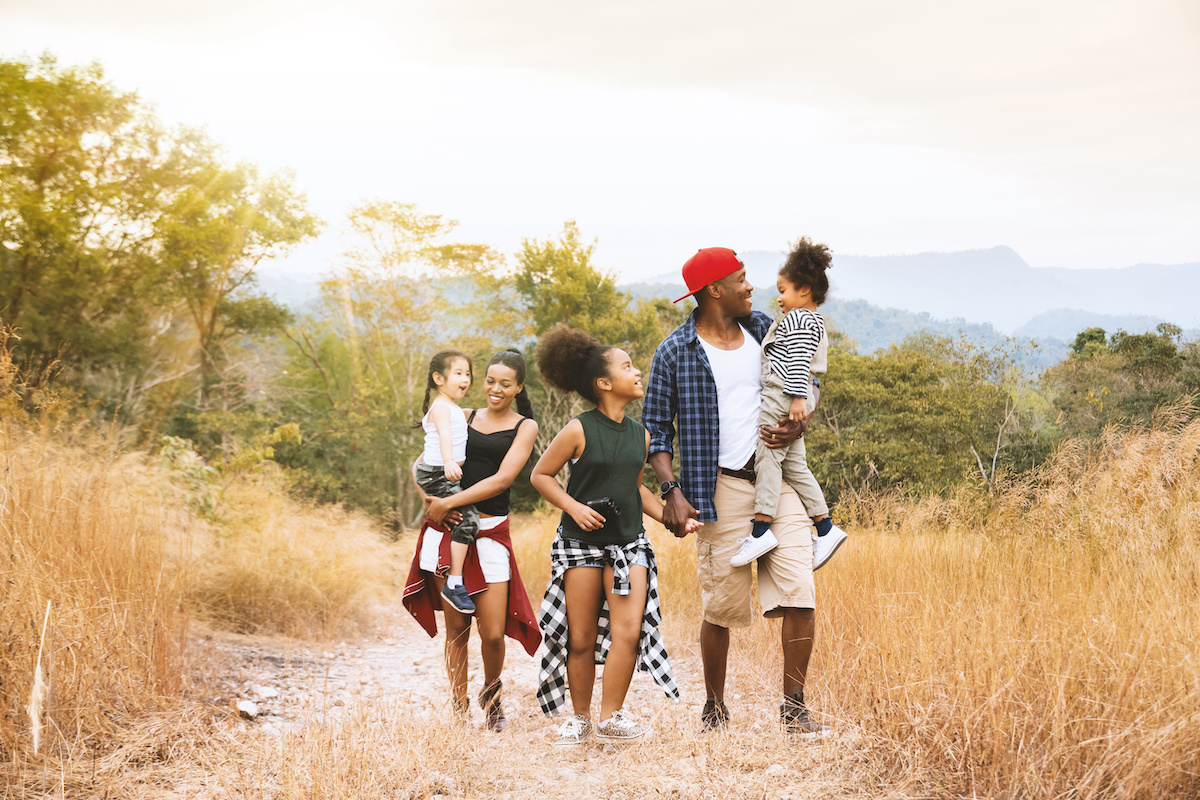
EXPEDIA’S 2022 GOAT TRAVEL TRENDS, UNPACKED
Where U.S. Travelers Are Heading in 2022:
Domestic travel, particularly to warm-weather beach destinations, remains a top choice for Americans, with 59 percent of U.S. survey respondents planning domestic-only trips for 2022. However, a significant portion (37 percent) are planning both domestic and international vacations in the coming year. These are the top-searched spots on U.S. travelers’ lists:
- Domestic: Orlando, Destin, Gatlinburg – Pigeon Forge, Panama City, and Maui
- International: Riviera Maya, Playa del Carmen, Tulum, Rome, Bali, London, and Paris
Scrapping the Schedule
The pandemic made it difficult to travel (or do anything on a whim), with 37 percent of U.S. travelers admitting to being less spontaneous since the onset of COVID-19. While travel advisories and guidelines will persist for the foreseeable future, travelers nonetheless are planning to embrace the impromptu and let loose on their future trips. A quarter (25 percent) of respondents said they are willing to be more spontaneous and live in the moment, and another 26 percent are aiming to be more flexible and go-with-the-flow this time around.
- How to get your GOAT: For travelers wanting to be more spontaneous, be on the lookout for last-minute deals and use the “free cancellation” filter on the Expedia app to find flexible rates.
The Splurge-cation
After canceled trips and postponed celebrations, travelers are ready to make up for lost time and go big to put themselves first and get the GOAT they deserve. Over the next year, 40 percent of U.S. travelers say they are more willing to treat themselves and spend money on their next trip. From indulging in luxurious experiences (15 percent) to upgrading on rooms or flights (16 percent) to visiting a bucket-list destination (32 percent), 2022 will be all about splurging on the things that make a trip go from good to great.
The study also revealed that travelers between the ages of 18 and 34 are the most likely to go big (80 percent compared to 56 percent of travelers over the age of 50), while Gen-X travelers are the most likely to splurge on a high-end restaurant (18 percent compared to 16 percent overall).
- How to get your GOAT: Get treated like a VIP by staying at Expedia VIP Access properties, top-rated hotels that offer member perks like spa credits, late check-out, and more. And for those looking to treat themselves to luxe flying, now is the best time to upgrade. According to data from Airlines Reporting Corporation (ARC), average premium economy ticket prices in 2021 were around 290 percent more expensive than economy tickets, whereas pre-pandemic, in 2019 they were a whopping 430 percent more expensive than economy3.
Immerse to Discover
Going big doesn’t just mean taking a bucket-list trip. In the coming year, American travelers are going after their GOAT by stepping outside their comfort zone (22 percent) and immersing themselves in a destination, culture, and experiences entirely different from their day-to-day (19 percent).
From trying new foods (40 percent) and experimenting with local delicacies (31 percent), to attending a local music event (14 percent), and seeking out off-the-beaten-track experiences and destinations (23 percent), U.S. travelers have a renewed curiosity to learn and experience the world.
- How to get your GOAT: Expedia’s handy “Interest” filters will help narrow activity and experiences searches. Try filtering by history and culture, or food and drink to indulge in a food tour to get the very best the destination has to offer.
Sensation Seeking
In 2022, travelers aren’t just craving new tastes and places, they’re also yearning for the feeling of being excited and exhilarated once again (41 percent), with 11 percent willing to try daring or high adrenaline activities and experiences and 24 percent looking to have an unforgettable night out.
Additionally, when it comes to their next trip, one-fifth (21 percent) of travelers are most excited about doing things they wouldn’t usually do, including sleeping under the stars (19 percent), traveling alone (17 percent) skinny-dipping (11 percent) or having a vacation romance (10 percent).
- How to get your GOAT: Whether it’s sky diving in Dubai or deep-sea diving in Oahu , Americans are ready to feel wind in their hair again and the rush of exploring the unknown. Use Expedia’s “Adventure & Outdoor” filter to narrow down experiences that will get the blood rushing and adrenaline pumping.
Unfiltered Enjoyment
A successful trip is no longer defined by likes on social media. Traveler priorities are shifting to focus on staying present and mindful. More than a third (36 percent) of U.S. travelers are searching for a sense of contentment and mental wellbeing on their next trip, and nearly a quarter (24 percent) plan to spend less time on their devices to be more present.
The trip experience Americans are looking forward to most is the chance to relax and do nothing (38 percent). To reach this sense of contentment, more than a quarter of travelers (27 percent) aim to spend more time in their destination to ensure they fully experience all it has to offer. Travel in 2022 will be about quality, not quantity, with travelers embracing the simple pleasures to truly achieve their GOAT with more meaningful impact.
- How to get your GOAT: Whether it’s relaxing at a Mexico spa retreat , or staying at the Tierra Patagonia Hotel & Spa in Chile with zero reception or Wi-Fi, it’s the perfect time to discover unplugged getaways that are sure to recharge the batteries.
It’s important to stay up to date with the latest government and travel advisories. For the latest information visit Expedia’s COVID-19 Travel Guide .
1 This study was conducted on behalf of Expedia by Northstar Research Partners, a global strategic research firm. The survey was conducted online from August 27th–September 6, 2021, across North and South America, Europe, and Asia-Pacific using an amalgamated group of best-in-class panels. The study was conducted among 12,000 respondents across 12 countries, amongst adults who are planning domestic or international travel in the next 18 months.
2 Based on lodging interest on Expedia.com for travel between Jan, 1, 2021 – Dec. 31, 2021 as of October 31, 2021.
3 Information is based on average premium and economy round-trip ticket prices for January through August for 2021 & for January through December 2020 and 2019, sourced from ARC’s global airline sales database for 2021.
See the 2024 Travel Trends
More Articles With Bucket List
From adventure to mindfulness, to trying new things and putting our phones away, these are the biggest travel trends you'll see in 2022.
The global impact of coronavirus is affecting travelers everywhere. Here's how you can prepare and what to expect if you booked travel with Expedia.
Experts Predict the 6 Biggest Travel Trends for 2022
Industry insiders share their thoughts on the way luxury travel will evolve and adapt in the new year.

Every item on this page was chosen by a Veranda editor. We may earn commission on some of the items you choose to buy.
Top travel industry insiders Brandon Berkson of Hotels Above Par and the newly launched HAP Concierge and travel photographer Ana Linares of @ananewyork , as well as the teams at luxury travel agency Essentialist , and luxury tour operators Insight Vacations and Luxury Gold have shared with us what they are anticipating in the year to come in terms of travel. Their brilliant insights will not only inspire a wealth of glamorous getaways but will also inspire us to be more mindful about the way we travel from sustainable, ethical, and locally minded perspectives that will reimagine the way we plan weekend road trips and long-term summer vacations for the better come 2022.
The Glamorous Return of Train Travel

"Travel in itself has become such a production that many travelers have turned to discover their own towns, nearby attractions and local destinations more than ever, which leads me to believe that traveling via train will be trending," says Linares. "There’s been a huge increase in this area of transportation, especially in Europe. The idea of traveling by train has been adapted by hotel brands like Belmond, which has increased its routes in the glamorous Orient Express." Belmond recently teamed up with legendary film director Wes Anderson to redesign a carriage on Belmond's British Pullman , shown here, merging yesteryear glamour with modern amenities.
Luxury Gold reports a 17% increase in demand for tours that include five-star rail journeys and anticipates luxury train transport to become a popular pastime for discerning travelers in 2022. Its most popular rail itineraries for the upcoming year are Ultimate Italy with the Venice Simplon-Orient-Express and the Majesty of the Rockies with Rocky Mountaineer Gold Leaf Service , showing that there is interest domestically as well as in Europe.
Luxury trains offer some key amenities that have made air travel more difficult and less appealing since spring 2020. Private traincars, more personalized service, better dining options, and skipping out on hectic airport lines are sure to bolster the trend of traveling by train in 2022.
A Travel Advisor is a Globetrotter's Best Friend

2021 proved to be the year of the travel advisor , and our experts anticipate that working with a travel agent will become a necessity for planning vacations of all kinds moving forward. Even if you're returning to a beloved destination, like Paris— one of our own top destinations for 2022 , a travel advisor can help you experience a place in a whole new way. Plus, there has been an array of exciting new hotel, restaurant, and other attractions opening since spring 2020, such as Cheval Blanc Paris (shown here), and an advisor can curate a list of new experiences for you to bring some excitement to your trusty annual itinerary if you don't want to deviate from tradition completely.
"There’s no better source to help you plan a trip and navigate the ever-changing restrictions and guidelines that come with traveling internationally," says Berkson. "Our hip travel agency, HAP Concierge, does everything for you, from flights to hotels to destinations, so you can be assured you're in compliance and not surprised by any pandemic-related travel obstacles that come your way."
Even when the ever-changing quarantine guidelines and varying testing requirements no longer feel overwhelming, working with the right travel agent will ensure that your trip is hassle-free and full of experiences you may not have come across from your own research, so that you're getting exactly what you need out of your vacation, whether it's a Mediterranean escapade or a long weekend in a new-to-you state.
Supporting Local

As many of us have taken greater efforts to support our favorite neighborhood businesses in light of the pandemic, Berkson predicts that will also translate to the way we travel and the kind of experiences we are looking to have away from our hometowns.
"I believe more and more people will continue to look into supporting boutique-style, locally owned businesses when they travel, from hotels to tour operators," says Berkson. "The pandemic devastated the tourism industry—many Americans are aware of that and want to do their best to help. Before the pandemic, there was a big trend surrounding voluntourism and giving back to the place you’re visiting; now, that trend is starting to resurface with a different head: supporting locally owned businesses and boutique hotels in that destination where you're vacationing."
You're likely to get the most out of your stay, whether you're visiting a city for the first time or go each year, by branching out with a luxury boutique hotel property as it likely offers one-of-a-kind experiences and insights that you wouldn't be able to have on your own.
Berkson loves San Miguel de Allende in particular for its unrivaled boutique hotel scene. Some favorites are Hotel Matilda (shown here) and Casa Hoyos.
Celebrating Life's Most Important Moments with Travel

The team at Essentialist has seen a rise in requests for honeymoons, big birthday destination trips, and friends or family gatherings among members for the new year. This also means that they are seeing a rise in bucket list trips and nostalgic vacations alike depending on the type of celebratory experience members are looking for.
After missing out on multiple birthday celebrations over the last two years, many are going all out with glamorous getaways, and delayed honeymoons are anticipated to be more luxurious than ever after a season of extended engagements and micro-weddings. We especially love the idea that family reunions may be getting some much-needed elevation to become trips we can be excited about investing in—no matching shirts allowed.
The team reports that destinations such as London, Paris , Italy, and top Caribbean islands will be hot spots for members who are looking to return to locales they've missed since the pandemic first hit that will offer comfort, familiarity, and fond memories of life before 2020. For other travelers, booking trips of a lifetime will hopefully quench the wanderlust that many experienced after nearly two years of reduced travel—particularly abroad—and the extra savings are leading to more members planning unforgettable itineraries around the world.
Prioritizing Wellness

Just as the pandemic travel tides seemed to be shifting in favor of city escapes over national parks earlier this fall, many travel companies and hotel brands alike have reported a shift back to nature-centric experiences, from The Hawaiian Islands to Bozeman, Montana and even more remote parts of Japan. Whether your idea of wellness is spa treatments and pilates or fly fishing and quiet nights by the fire, much of the year's travel will be centered around destinations and itineraries that rejuvenate, de-stress, and help us to connect with nature as the times continue to feel unprecedented.
The Essentialist team also noted that the prioritization of wellness in 2022 travel plans has people interested in "self-improvement and a focus on more meaningful, intentional travel for the new year." The team says both wellness retreats and destinations that offer unique wellness experiences will be big for 2022. Linares says that travelers will be looking to visit destinations that make them pause and be truly present, offer unforgettable experiences, and connect more with the location they are visiting through a lens of sustainability. Just as we will be seeking wellness in our vacation, we will also want to seek the well-being of the destination and its locals.
Making Each Trip Meaningful

"There is a new concept of travel that emerged during the pandemic called 'travel less, travel better' which resonated with the way I took on travel starting in 2021 when I had my first photoshoot abroad," says Linares. "I saw a shift on the way I approached that first trip. I remember ensuring I was making the best of my time and that it was more meaningful than before. It doesn’t necessarily mean that you will travel less but when you do, make it meaningful."
Essentialist and Insight Vacations shared that longer trips are a trending concept for luxury travel in 2022 as people want to spend more time exploring one destination and don't want to have to deal with crossing multiple borders with varying restrictions. Insight Vacations has seen a 10% increase in bookings on tours that are two weeks or longer.
While Italy is the most popular destination for single-destination trips in 2022 for Insight Vacations and Luxury Gold, the brands have noticed a 40% increase for domestic travel in the U.S. as well as a 15% increase in single-destination bookings for Portugal, Ireland, Iceland, and Turkey compared to 2019.
Join us for a VERANDA Field Trip in 2022, where we will be exploring parts of the U.S. and Europe with a design-focused lens. This year, we will be taking trips to California, Virginia, and Paris, each with unique itineraries that offer exclusive experiences and bring the pages of VERANDA to life.
Lauren Wicks is a freelance writer and editor based in Birmingham, Alabama. Before going on her own, Lauren worked for brands such as VERANDA, EatingWell, and Cooking Light , and she covers all things lifestyle from interior design and luxury travel to wine and wellness.

The 15 Best Hamptons Hotels

49 Museums You Need to Visit in Your Lifetime

The 8 Most Beautiful Gardens in France

Two Luxury Journeys That Immerse You in Nature
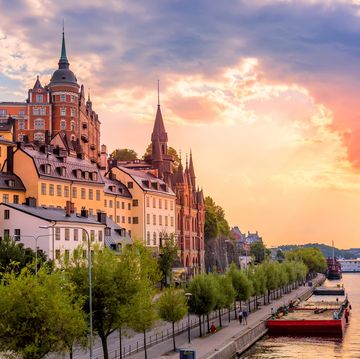
How to Spend a Perfect Weekend in Stockholm

11 Perfect Girls' Trip Destinations in the U.S.
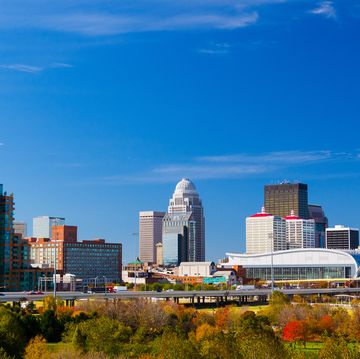
How to Spend a Perfect Weekend in Louisville, KY

Rare Vintage Photos of NYC’s Iconic Central Park

How to Celebrate the Spring Equinox in Japan
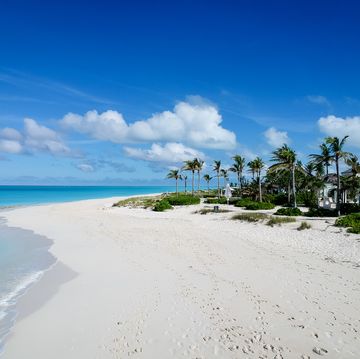
17 of the Most Beautiful Caribbean Islands
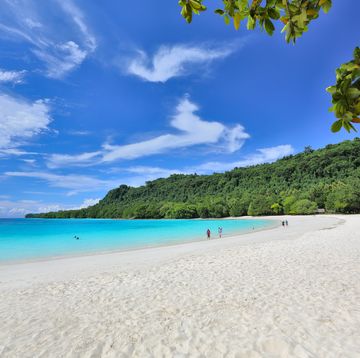
The 28 Most Beautiful Beaches in the World
- Course Catalog

TOURISM TRENDS 2022
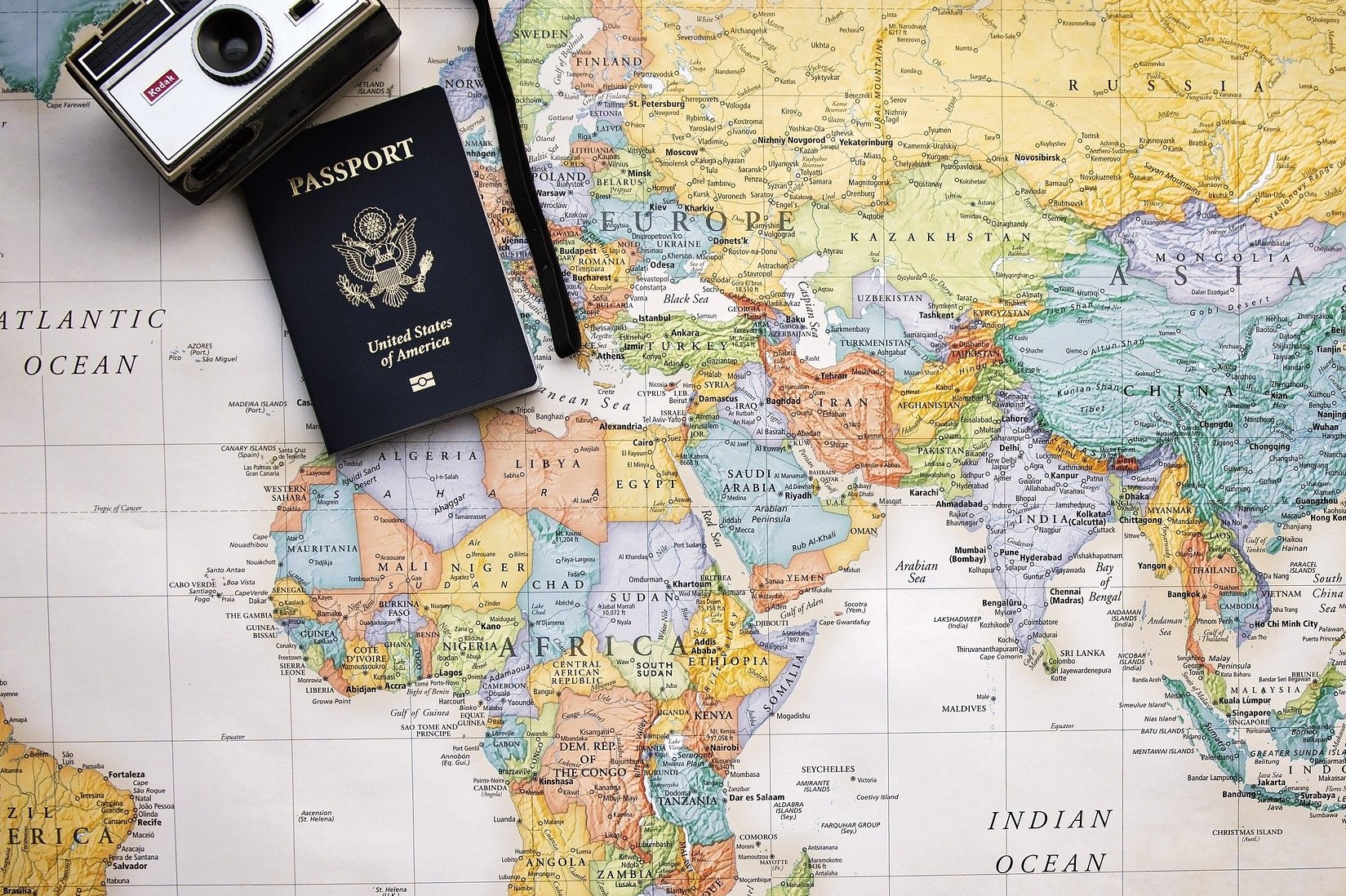
11 Aug TOURISM TRENDS 2022
The situation for tourism remains rather unusual as a result of the ongoing COVID-19 pandemic.
The crisis has marked a significant change for everyone, and above all for tourism, one of sectors hit hardest by the virus. 2020 was the year in which international tourism came to a near-complete standstill, and the only alternatives were domestic and local tourism.
2021 has seen some improvements, but only in a very subtle way as restrictions are still in place and many countries keep their borders fully or partially closed.
It is difficult to make an estimate for 2022 as it is not known how the pandemic will evolve. However, it is possible to talk about the new tourism trends that are likely to emerge over the coming year: – International travel with restrictions still maintained by both destinations and airlines in order to offer 100% security to the consumer.
– Reinforcement of COVID-19 testing; two years after the pandemic, COVID testing will still be in place as a preventive measure. – Conscious travel will be advocated. Travel to more distant destinations, but with prolonged durations of stay, as consumers look to enjoy as much of each place they visit as possible. – Green travel. Climate change is a problem that is present and growing. Consumers now are much more responsible and aware of the reality they live in on daily basis.
– A new trend is the “ed-ventures”. It is about combining education and holidays for the youngest members of the family. While adults may need to telework or attend meetings, their children can be doing workshops and learning in a playful way.
All products are independently selected by our editors. If you buy something, we may earn an affiliate commission.
The biggest travel trends for 2024
By Sarah Allard

If 2022 was all about a return to travel, then 2023 was the year we went further than ever before. Travellers took to the skies, rails, roads and seas to tick off major bucket-list moments, with Arctic adventures, luxury yacht cruises and even the first tourist trip into space .
In 2024, travellers will be putting what’s important to them front and centre of their plans, valuing deeper experiences that leave a positive impact, time spent with loved ones and wellness moments that last well after checkout. We’ll be choosing destinations carefully, slowing it down to enjoy the silence and the stars, indulging in our love of food in new and interesting places, and immersing ourselves in wellness practices that help us live longer.
These are the 20 travel trends likely to guide how we see the world in 2024.

Astro tourism
1. Astro tourism
What’s the trend? Astronomy, of course, is a field of study that has been around since the dawn of civilisation, and the act of gazing up at the stars has long been a source of soul-soothing wonder. Today, the more society falls deeper into an ever-expanding virtual world, the more we feel a need to broaden our horizons in the real universe. Astro tourism, or star bathing, is the act of travelling with the aim of catching sight of astronomical phenomena – disappearing to lands devoid of any pollution, crowds and traffic, where we can focus solely on the skies above and while away hours gazing at the stars, planets and constellations overhead.
Why will it matter in 2024? Increasingly, wellness-centric hotels and spas are creating the space for guests to gaze upwards, watching for comets, spying constellations and identifying patterns in the glittering expanse. In the UK, Port Lympne has opened the Lookout Bubble, a glass dome allowing guests to sprawl out on king-sized beds and study the stars. Further east on the Arabian Gulf, Zulal Wellness Resort is surrounded by the expanse of the Qatari desert – the ultimate destination for pollution-free astromancy, with dedicated workshops and stargazing sessions for families and children looking to learn more about the cosmos. Safari company Desert & Delta organises trips for travellers looking to soak up the stars across Botswana and Namibia, where guests can sleep in tents at remote locations such as the Makgadikgadi Pans, one of the world’s largest salt flats, and spend nights with uninterrupted star vistas. Similarly, Tswalu is a South African safari camp with star beds set on a sleep-out deck in the Korannaberg mountains. And 2024 happens to be a big year, astronomy-wise, from mind-boggling eclipses to spectacular meteor showers – plus, scientists are predicting the best displays of the northern lights in 20 years, according to the Guardian , as we approach the next solar maximum (the sun’s peak of its 11-year activity cycle). Olivia Morelli
2. Eco diving
What’s the trend? A rise in divers choosing their travel destinations based on the sustainability of the scuba centres, and having a more positive, regenerative impact on the ocean once there.
Why will it matter in 2024? In 2022, UK marine ecology charity The Reef-World Foundation found that 95 per cent of divers wanted to book with sustainable operators, but struggled to do so. In response to this, the Professional Association of Diving Instructors (Padi) launched its Eco Center accreditation on World Earth Day (22 April) 2023, with the United Nations Environment Program and Reef-World itself. The steps required to earn this green status are so rigorous – including sharing evidence of conservation activities and a real reduction in environmental footprint – that Padi advised operators to allow at least 12 months to hit the criteria, taking us to… Earth Day 2024. After an initial figure of just 11 worldwide, there are now 100, and Padi has set a goal to reach 660 by 2030 – a 10th of its membership. “South East Asia currently has the highest density (more than 20), along with the Caribbean ,” says Julie Andersen of Padi. So what does this mean for divers and their trips? “The type of conservation work done and reported on depends on the Eco Center,” Andersen explains. “Those in the Caribbean offer coral replanting programmes, key for regenerating coastlines. In Baja, Mexico , they’ve developed citizen science courses, collecting data for whale conservation.” There are also a number of new Padi courses being launched for any diver to take anywhere, including the Global Shark and Ray Census in August 2024, as well as the relaunch of the Coral Reef Conservation Specialty course before December. Becky Lucas
3. Home swapping
What’s the trend? Increasingly, discerning travellers are looking to stay away for longer stretches, while the rise of remote jobs post-pandemic means that working and living abroad has never been more appealing. The catch? Forking out on hefty accommodation fees while you’re at it. Enter home swapping: the perfect solution to guarantee yourself a (free) home abroad while you offer up your own in exchange – for weeks or even months at a time.
Why will it matter in 2024? As the cost of holidaying continues to climb, home swapping is an affordable alternative to splashing out on expensive hotels or Airbnbs. And while the concepts of couch surfing and house exchanges have existed for decades, several slick new platforms are redefining what home swapping looks like today. Twin City, which operates in cities as far-flung as Lisbon and Los Angeles , has curated a community of 1,100 plus carefully vetted users in just eight months. For an annual subscription fee of £150, members can find Twins to connect with through the platform, and are encouraged to exchange local recommendations for their city as well as their homes, enabling members to feel as if they’re swapping with a trusted friend rather than a stranger. Meanwhile, Kindred, a home-swapping platform where members rack up credits for each night that they exchange homes, raised $15 million in funding this year to expand operations across the USA and Europe, and currently has 10,000 plus homes in more than 50 cities. Members simply pay a cleaning and service fee for each stay, while the cost of the stay itself is free. Or skip out on membership fees entirely and head straight to TikTok, where Gen Z appears to be spearheading the home-swapping movement on social media. Inspired by cult film The Holiday , trending tags #houseswap and #homeswap have garnered more than 23 and 20 million views respectively, with users utilising the platform as a means to advertise their homes, discover like-minded peers to swap with and document their adventures along the way. Gina Jackson
4. Train stations are the new food destinations
What’s the trend? Train stations around the world are usually passed through as quickly as possible, having not been designed for commuters to stay and hang out. Nowadays, as travel delays increase and visitors want more local experiences, it pays for train stations to welcome travellers with shops, restaurants and bars for them to explore. In an effort to create a more dynamic visitor experience, historic train stations are being revamped, with bespoke food and drink offerings as an integral part of the redesign.
Why will it matter in 2024? As train stations are renovated to accommodate more travellers and update old infrastructure, local restaurants and bars are being added to attract more customers. In 2023, the new Moynihan Train Hall in New York City became home to The Irish Exit, a bar from the team behind the acclaimed Dead Rabbit, and Yono Sushi by trendy BondST, plus outposts of beloved NYC restaurants Pastrami Queen and Jacob’s Pickles, with Mexican hotspot La Esquina coming soon. Platform 1 a new bar and restaurant that opened in November underneath Glasgow Central Station . The cave-like space, with its historic brick arches, serves street-food-style dishes and craft brews made in the on-site microbrewery, plus there’s an outdoor beer garden. As part of its renovation, Toronto’s Union Station launched Union Market in May 2023 with favourite local food retailers Manotas Organics, Chocolatta Brigadeiro’s, Patties Express and Kibo. Meanwhile, in Somerset, Castle Cary station is in the process of a revamp, with nearby hotel The Newt creating a creamery, cafe and co-working space, which is set to open in 2024. Also on tap for the next few years is the completed renovation of 30th Street Station in Philadelphia, with plans for a 20 per cent increase in concession space that will focus on local purveyors. Devorah Lev-Tov

5. Sports tourism
What’s the trend? No longer the domain of lads on tour keen to sink as many pints as possible with one eye on a football game, sports tourism has evolved in the past few years with a new generation – and type – of sports fan emerging thanks to glossy TV documentaries ( Formula 1: Drive to Survive , we’re looking at you). Now, we’re taking our fandom out of the house and following a host of different sports in destinations across the world, planning holidays that hinge around seeing games, races and other activities in exotic locales, and extending trips on either side to see the sights too.
Why will it matter in 2024? A little event known as the Olympic and Paralympic Games anchors the 2024 sports calendar. It kicks off in Paris in late July and runs until early September , during which time more than a million tourists are expected to check in across the French capital. The games have inspired city-wide projects such as the €1.4-billion clean-up of the Seine, which , all going well, will allow public swimming in the river for the first time in a century. Elsewhere, the Tour de France starts in Italy for the first time in 2024, with competitors speeding off in Florence before heading to Rimini on the Adriatic coast and then north to the Apennines through Emilia-Romagna. New bike routes in the area have been released by tour operators such as Ride International Tours and Ride Holidays for cycling enthusiasts keen to join in the fun. Sarah James
6. Coolcationing
What’s the trend? For the vast majority of folk, summer holidays used to be about following the sun, seeking the heat – watching the mercury climb and hitting the sands. With the intense, record-breaking temperatures of recent years, however, many are considering travelling in the opposite direction: booking "coolcations" in temperate destinations, which also benefit from being less crowded.
Why will it matter in 2024? Rising temperatures caused by the climate crisis have resulted in the hottest recorded summer in the UK – just over 40℃ in July 2022 – while 2023, with a sweltering summer in much of Mediterranean Europe, North America and China – is on track to be the hottest year ever. Little wonder that many travellers are thinking again before booking literal hotspots such as the South of France and Sicily in July or August. A survey for luxe travel network Virtuoso found that 82 per cent of its clients are considering destinations with more moderate weather in 2024. Destinations such as Iceland, Finland and Scotland, according to Intrepid Travel, along with Latvia, which is surging in popularity. “We’re seeing an increase in those holidaying further north,” says Andrea Godfrey of Regent Holidays. “Scandinavia and the Baltics are both getting noticed more: they offer a more pared-back style of holiday but have some lovely beaches, and forests and lakes for both relaxation and adventure activities.” Cooler temperatures are particularly well suited to family travel too. “We’re getting far more enquiries from families for destinations that offer summer sun but also respite from the high temperatures being experienced in beach resorts across the Med,” says Liddy Pleasants, founder of family specialist Stubborn Mule Travel. “Kayaking in Norway, with its midnight sun, for instance, and cycling or hiking in Slovenia, which is also very good value.” Time to ditch the SPF50… Rick Jordan

Gig tripping
7. Gig tripping
What’s the trend? For years, athletes and wellness gurus were the big headliners at retreats. But rock stars are, well, the new rock stars of travel. Call it the Swift Effect. Destination concert business is up more than 50 per cent, led mostly by Taylor Swift, says Janel Carnero, a travel advisor at Embark Beyond. In the USA, tickets for Swift’s Eras Tour cost thousands and were still impossible to score. Music fans are realising they can pay less and have a more memorable experience by seeing their favourite pop icons perform in say, Amsterdam or Milan . Tours from performers such as Pearl Jam, U2, Doja Cat and Madonna will anchor trip itineraries, while music festivals (Glastonbury sold out in less than an hour) will be major catalysts for travel.
Why will it matter in 2024? New music festivals, including Untold in Romania's Cluj-Napoca, are introducing travellers to undiscovered destinations, says Alexandrea Padilha of Fischer Travel. And it’s no longer just about the music, says Carnero. “It’s the social aspect of sharing experiences with friends,” she adds. Hotels and travel companies have taken note and are creating the equivalent of backstage VIP experiences for guests. Global adventure collective Eleven has recently introduced Music with Eleven. The programme’s dedicated team of music-industry insiders (including Chris Funk, guitarist from the Decemberists) custom design itineraries that might include sitting in on a recording session at Flóki Studios, just outside the Arctic Circle at Deplar Farm in Iceland. And Rhythm & Sails hosts musicians on its catamarans. The company’s music director, Anders Beck of the jam band Greensky Bluegrass, curates the line-up of artists who perform sessions onboard and in ports as you island hop around the Caribbean . Jen Murphy
8. Resorts will help you biohack your health span
What’s the trend? Longevity is the latest wellness buzzword thanks to best-selling books such as Outlive and the hit Netflix documentary Live to 100: Secrets of the Blue Zones . Between 2021 and 2022, venture-capital investment in longevity clinics more than doubled from $27 million to $57 million globally, according to analysis from longevity research and media company Longevity.Technology. Now, the science of extending life and optimising health has become the focus at hotels. Blue Zones retreats are the new boot camps and even sybaritic resorts are offering the latest biohacks. Poolside vitamin IV anyone?
Why will it matter in 2024? Since the pandemic, feeling good trumps looking good. “People have become aware of the critical importance of developing a more proactive, preventive approach to health on all levels,” says Karina Stewart, co-founder of Kamalaya, a wellness retreat in Koh Samui, Thailand . This means a new willingness to go beyond diet and exercise and embrace sci-fi-sounding bio-regenerative treatments such as ozone therapy and hyperbaric oxygen chambers, both on offer at Kamalaya's new Longevity House. Luxury hotel brands are embracing the trend too. Six Senses Ibiza recently teamed up with biotech company RoseBar to offer guests full diagnostic testing. Maybourne Hotel Group is collaborating with wellness tech pioneer Virtusan to help guests boost performance. And Four Seasons Resort Maui at Wailea administers treatments such as stem cells and NAD+ (aka the fountain of youth) through its partnership with Next Health longevity centre. At 1 Hotel Hanalei Bay in Kauai, guests are welcomed with a B12 shot instead of bubbles and the resort’s new wellness-specific rooms come with recovery-boosting mod cons including infrared light mats. If the trend continues, the secret to longevity may be as easy as taking more holidays. Jen Murphy
9. Peak season gets the cold shoulder
What's the trend? There’s been a dramatic recent increase in shoulder season travel to Europe’s most popular destinations (particularly France , Spain , the UK and Italy ), which is set to continue in 2024. Luxury travel specialists Original Travel has launched new shoulder season itineraries to locations traditionally in demand during the summer – including the crystalline seascapes of Sardinia and Corsica – after seeing 14 per cent more bookings for September 2023 than for August 2023. Pegi Amarteifio of Small Luxury Hotels of the World shares similar insights. “Comparing phone reservations in 2023 against 2019, we’ve seen a 33 per cent increase for March to May and a 58 per cent increase for September to November , a pattern reflected across our other booking channels too.”
Why will it matter in 2024? A combination of social, economic and environmental factors is driving this trend into 2024. The cost of living crisis means a heightened focus on value. For 62 per cent of respondents to Booking.com’s 2024 travel trends survey, this is a limiting factor for 2024 travel planning, so much so that 47 per cent of respondents are even willing to take children out of school for cheaper off-peak travel. Shoulder season travel is also becoming more attractive due to rising temperatures, and more feasible due to flexible working. Layered on top of these practical considerations is an emotional motivation too: travellers are craving authenticity more than ever, seeking a tranquil, local feel when abroad, rather than Where’s Wally beach scenes. Toyo Odetunde
10. Private group travel
What’s the trend? The post-pandemic desire to gather friends or family and embark on a shared holiday experience shows no sign of abating – in fact, it’s on the increase in luxury travel, as people appreciate the benefits and savour the moment, from 3G family groups to 50-something empty-nesters keen to rekindle life-long friendships. Just don’t take Succession ’s family outing to Tuscany as a role model.
Why will it matter in 2024? “While some predicted group travel would peak post-pandemic, we’ve seen it have a lasting, positive impact with private group bookings continuing to be a dominant trend,” says Tom Marchant of Black Tomato, for whom group travel now accounts for 30 per cent of bookings. The company has just launched its See You in the Moment series to cater for the demand: it uses a mood board of over 35 experiences themed around key flash points, from The Meal (a backcountry feast served on the North Rim of the Grand Canyon, for example) to The Challenge (rafting down the Apurímac in Peru, perhaps), all designed to create lasting memories. For Scott Williams, meanwhile, multi-generational travellers are thinking big: why take one house when you can take a whole estate, such as Meli on Paxos in the Greek Islands, which sleeps 17? Other groups are taking to the water, with Red Savannah reporting an increase in bookings for Turkish gulets, Egyptian dahabiyas and Indonesian phinisis. Scott Dunn have seen an increase in bookings amongst groups of friends, with 30 per cent of respondents in a recent survey saying they were planning trips for 2024 that included ski trips to France, adventure travel in South and Central America, and beach breaks on Antigua and Barbados. Empty-nesters are also a growing force, with groups of couples in their 50s to 70s hiring villas in the shoulder season for cultural weeks away, and all-female groups – mainly aged between 50 and 65 – who are proactive in wanting to renew long-term friendships. “We had one repeat group that included several cancer survivors,” says Sarah-Leigh Shenton at Red Savannah. “A hammam afternoon in Turkey was a deeply bonding experience and they’ve since travelled to Jordan and Sicily together.” Rick Jordan
11. AI aims to be your sidekick
What's the trend? Early last year, after OpenAI’s ChatGPT broke the record as the fastest-ever growing consumer app, travellers started playing around with AI chatbots to get inspiration on where they could go. More recently, major travel booking platforms have started to integrate AI chatbots into the booking experience. But if 2023 was the year of AI chatbots wanting to plan your trips , 2024 will be all about how AI aspires to be your travel sidekick. A wave of new AI-powered features and products aims to support travellers on the ground – all while raising concerns around the potential negative impacts as AI becomes more widely integrated with our travels.
Why will it matter in 2024? AI will start to make more real-time interventions in our travels in 2024. One practical example is live translation , which Samsung plans to launch on its 2024 Galaxy devices. Imagine calling somewhere you want to visit to get information without worrying about whether staff speak the same language as you. Another example is greater AI personalisation in popular apps you already use. Uber’s CEO Dara Khosrowshahi has recently touted the company's increasing use of personalised AI algorithms , which will learn about your habits and make suggestions based on what you’re doing. For the true early adopters, real-time travel interventions could also mean ditching your screen entirely and clipping a screenless personal translator and travel assistant to your chest. This is the unusual idea behind the new talking and projecting AI Pin from Humane , a start-up backed by investors including OpenAI’s Sam Altman, that promises to function a bit like the universal translator from Star Trek . Will anyone want to actually wear the pin or will it go the way of previously hyped devices such as Google Glass? It certainly raises a host of ethical questions about privacy and data protection. Yet the more that AI products successfully help in addressing on-the-go problems, the more travellers will come to rely on them too. JD Shadel
12. Skip-gen travel
What’s the trend? Skip-gen travel describes when grandparents holiday with grandchildren, in other words, "skipping" a generation. “In the past few months, I've had around twice as many enquiries as usual for grandchild/grandchild bookings,” says Clio Wood, founder of family retreat company &Breathe . “There’s been a rising trend of grandparents taking their grandchildren away,” agrees Ollie Summers, Head of Sales at bespoke operator Scott Dunn . “Often to places that have a sentimental meaning to them.”
Why will it matter in 2024? Several travel agencies have created itineraries to cater specifically for this demand in 2024. “Skip-gen safaris are emerging as a micro-trend from the UK, reflecting a niche traveller group now well established in the US luxury market,” says Liane Goldring of Mahlatini Luxury Travel . “The grandparents are usually in their 70s and still active enough to fully embrace a fully guided safari adventure.” Original Travel, meanwhile, has relaunched its Bonding Holidays Collection , featuring trips focussed on discovering something new together, such as its 14-day Family Ranching itinerary in the American West. Some of this growth can be attributed to big-ticket lockdown promises coming to fruition. Now, amid the UK’s cost of living crisis, parents are also keen to make the most of the time and childcare support of their typically baby boomer, more comfortably retired parents. Plus, the global ratio of living grandparents to grandchildren is higher than ever, thanks to a combined increase in life expectancy and drop in the number of children per person. We’re even said to be living in the "the age of the grandparent". Don’t expect this trend – or your grandparents – to slow down anytime soon. Becky Lucas

Glamorous train travel
13. Train travel gets glam
What’s the trend? Rising climate consciousness has fuelled a rail travel revival, the luxury train niche is reaching new heights of popularity, extravagance and ambition. Travel booking platforms are reporting growing demand for luxury rail trips , where the journey is, yes, the destination. In fact, new design-forward train lines increasingly rival the finest hotels for the culinary experiences and bells and whistles on offer.
Why will it matter in 2024? A new wave of rail lines and itineraries launching in 2024 puts an emphasis on deeper immersion into the culture and landscapes of the destinations, which are more and more off the beaten track. Responding to growing demand for luxury train travel among its user base, specialist platform Railbookers plans to launch arguably the most geographically extensive and expensive luxury train itinerary around. With prices per person starting at $113,599, the 80-day Around the World by Luxury Train voyage will cross four continents and 13 countries. Beginning in August , the slow journey will string together existing luxury rail trips including Canada’s Rocky Mountaineer from Vancouver to Jasper and India’s Maharajas Express from Delhi to Mumbai. In Asia, the previously paused Eastern & Oriental Express is making a grand comeback starting in February, with carriages getting an upscale revamp and its legendary route being retraced through Malaysia's landscapes. Meanwhile, Japan is a hot destination for its scenic train journeys such as the exclusive Train Suite Shiki-shima , which quickly closed applications for its 2024 trips due to demand. And in Europe, six new train lines will commence or terminate in Rome under Accor's La Dolce Vita umbrella, with suites designed by starchitects Dimorestudio, building on the cultural legacy of the famous Orient Express . JD Shadel
14. Restaurateur-owned hotels
What’s the trend? Restaurants and hotels are the two linchpins of the hospitality industry. And naturally, the two are often intertwined on one premises. Until recently, though, most hotels weren’t started or owned by restaurateurs. Yet as food-focused travel keeps increasing, with people hankering for the next hot reservation and planning entire trips around discovering a culture through its food, it makes sense that restaurateurs are adding hotelier to their CVs – and ensuring their new properties have impressive food offerings. We’d be remiss not to mention Nobu, which began as a restaurant in 1994 and in 2013 launched its global hotel brand, as a harbinger of the trend.
Why will it matter in 2024? Just as design brands (RH, West Elm) have opened hotels in recent years, now restaurateurs are getting in on the action. In the USA, restaurateur and 12-time James Beard award nominee Sam Fox has just launched the Global Ambassador in Phoenix, Arizona, with five restaurants. Santa Barbara’s Good Lion Hospitality is relaunching Petit Soleil , a Californian wine country boutique hotel, with a new bar and restaurant slated for next spring. The Lafayette Hotel & Club was debuted last summer in San Diego by Arsalun Tafazoli, founder of a local hospitality group that operates 16 bars and restaurants. The hotel has five restaurants and bars, with two more opening by the end of the year. In Dallas, Harwood International, which owns a dozen or so restaurants in the area, opened Hôtel Swexan in June. In the St Gallen region of Switzerland two hotels were recently added to beloved restaurants: the revamped Mammertsberg and Gasthaus Traube . In Slovenia, AS Hotel is a new place to stay launched Sebastjan Raspopović, son of chef Svetozar Raspopović-Pope of renowned restaurant Gostilna AS in Lublijana. Aside from a restaurant by Raspopović-Pope, the hotel has an eatery by Michelin-lauded chef Ana Roš. Finally, R48 , and its lauded Chef’s Table, was opened in Tel Aviv last spring by R2M Hospitality Group, which also runs restaurants CoffeeBar and Herzl 16. Devorah Lev-Tov
15. Silent travel
What’s the trend? In an age of overstimulation, silence might be just what we need from our travels in 2024. Offering a chance to restore and reset, silent travel represents a more mindful kind of trip, one that doesn’t leave you needing a holiday to recover from your holiday. Silent meditation retreats are an increasingly popular wellness trend, but silent travel also encompasses secluded nature resorts, sleep retreats , quiet hotels , silent walking tours and even silent disco and concert experiences.
Why will it matter in 2024? Saturated with stress and screen time, many of us are looking for ways to disconnect. The silent walking trend that recently took TikTok by storm reflects a growing impulse to escape the noise of our tech-fuelled lives and embrace the quiet, with promising implications for wellbeing. One 2015 study suggests silence may help to stimulate brain development, while another found that two minutes of silence during or after relaxing music increased the music's calming effects. With the Global Wellness Institute forecasting a 21 per cent increase in wellness tourism in the next two years, what better counter to the chaos of our always-on lives than silence? Silent travel is also part of a move towards more sustainable tourism. Quiet Parks International , for example, offers unique nature experiences in dedicated quiet spaces, reducing noise pollution for the surrounding wildlife. Silent travel opportunities abound in 2024. Kick off the year with a silent retreat in Portugal (with Innate ) or Italy (with Mandali ). More adventurous silent-seekers can trek the peaceful Japanese Kumano Kodo trail, or explore Finland’s Arctic landscape with a Silence & Nature Tour . For a tailor-made silent experience, Black Tomato’s Blink camp offers luxury accommodation in the world’s most remote settings, while its Get Lost programme promises to help you find yourself by getting lost in a far-flung location. Tasha Kleeman
16. Urban gardens
What’s the trend? Never mind the biophilic office and those pot plants you forget to water: whole cities are going green as architects and planners create leafy microclimates amid the grey concrete to help keep us cooler, connect communities and even feed us.
Why will it matter in 2024? Having trees and gardens in our cities is a pretty good idea. King Nebuchadnezzar certainly thought so, which is why his Hanging Gardens of Babylon made it into travel’s first-ever bucket list – the Seven Wonders of the Ancient World – back in the 2nd century BC. Nowadays planting trees creates much-needed shade, stores carbon and increases biodiversity, but it also makes our cityscapes so much nicer. While Valencia, an early adopter of urban greening with its 12km-long Turia Garden in 1986, is the 2024 European Green Capital, France is busy planting trees like there’s no tomorrow: go to Paris for the 2024 Olympics and you’ll spot budding new forests growing in Place du Colonel-Fabien, Place de Catalogne and in the Charonne district, while Bordeaux’s Grandeur Nature project includes urban cooling islands, micro-forests and rain gardens. All of which will doubtless be discussed at the ISHS Green Cities 2024 symposium, hosted by RHS Garden Wisley in Surrey, England, in September. Meanwhile, on Cyprus – an island that experienced temperatures of 44℃ in 2023 – the new Salina Park opens in time for summer shade in the seaside city of Larnaca. In Brazil, Rio’s Hortas Cariocas is a groundbreaking achievement that will be completed by the end of 2024: the largest urban vegetable garden in the world, connecting 56 community gardens across favelas and schools. And in London, the £1-billion Google building in King’s Cross will show just what can be done with one structure. Designed by Thomas Heatherwick, the "landscraper" – only 11 storeys high but stretching out longer than the Shard is tall – is hoped to provide a blueprint for future urban projects: running along the rooftop is a multi-level garden, with wildflowers, lawns and decked seating areas, set with more than 55,000 plants and 250 trees. Can you dig it? Rick Jordan
17. Back-of-house tours
What’s the trend? Greener hotels giving us a look behind the scenes to show us – not just tell us – they're sustainable. We don't mean a look-see at solar panels or composting, but heart-lifting experiential tours that help us appreciate why it matters to support socio-economic uplift through tourism. In South America, Blue Apple Beach invites visitors to get up close and personal with the community work it does in Colombia through its impact fund. Founder Portia Hart wanted more than token-gesture carbon offsetting, where locals themselves could decide how money was spent. In Africa, guests of the Bushcamp Company contribute to initiatives through the Luangwa Conservation and Community Fund. A popular excursion in Zambia is visiting the boreholes that are installed with outreach funds. Each pump provides fresh drinking water to hundreds of people a day, and visitors who spend time with those gathered get a very tangible insight into how such provisions funded by hospitality can literally change lives in regions most affected by a warming planet.
Why will it matter in 2024? Transparency is on the up as the European Union's Corporate Sustainability Reporting Directive comes into force and greenwashing is coming close to being officially outlawed. A year of droughts, floods and heatwaves also reminds us we need to make better-informed choices in our travel planning – and all the better if we can also get a crash course in the science and sociology of positive impact. Experiences that go beyond explaining responsible practices, but demonstrate a deep respect for communities on the climate-change frontlines and help make their challenges relatable to visitors are especially helpful. Juliet Kinsman
18. Wild feasting
What’s the trend? Have you ever noticed how food always tastes better outdoors? But in today’s modern world many of us are more used to eating a sandwich while staring at a screen. Wild feasting describes the trend for beautifully curated culinary experiences in natural environments with the incorporation of hyper-local and foraged ingredients. In Sweden, for example, you can tap into a network of do-it-yourself outdoor restaurants where you book a table in a scenic location, search for nettles, birch leaves, lingonberries and trumpet chanterelles, and then cook them on an open fire according to a recipe card provided by a Michelin-grade chef.
Why will it matter in 2024? A greater range of wild feasting opportunities will give urbanites a chance to properly connect over food. Leading the way is Noah Ellis, founder of the UK's Nomadic Dinners. “Since launching in 2018, we experienced compounded year-on-year growth for our feasting and foraging experiences,” he says. In 2024 he will be hosting a new series of fire feasts, including one set among the bluebells. Also tapping into the zeitgeist is TikTok star Alexis Nikole Nelson (aka the Black Forager) who will publish a book about wild food in 2024. And don’t forget, 2024 is the last year you will be able to eat at Copenhagen ’s legendary, foraging-focused restaurant Noma before it turns into a test kitchen and closes to the public. Another innovator is Holmen Lofoten’s Kitchen On The Edge Of The World series in the Norwegian Arctic Circle, where guests can participate in four nights of wild feasts cooked by top chefs. In 2024, these will include Lennox Hastie, José Pizarro and Heidi Bjerkan. Ingunn Rasmussen, owner of Holmen Lofoten, says: “Now, as when we were little kids, gathering around a bonfire in the wilderness, sharing stories, feasting under the stars in these magical, remote surroundings is one of the absolute highlights, both for our guests and for us.” Jenny Southan
19. Plan-free travel
What's the trend? Saying no to endless scrolling to plan every inch of a trip, and saying yes to spontaneity instead. The power of the algorithm-spawned era of Fomo travel is waning, with those once secret spots made Insta-famous becoming tired and cookie-cutter, and the drive to plan a trip around them losing momentum. The rising counter movement is travel with no plans at all.
Why will it matter in 2024? The plan-free appeal is going one step further in 2024. Booking.com recently reported that 50 per cent of UK travellers want to book a surprise trip in 2024, where everything, even the destination, is unknown until arrival. And it’s possible to do it via travel companies such as Black Tomato, whose Get Lost service offers customers the ability to simply select a preferred environment – polar, jungle, desert, mountain or coastal – and leave its team decide everything else. “While we launched Get Lost several years ago, post-pandemic we’ve seen a notable and rising uptick in bookings and enquiries,” says Black Tomato co-founder Tom Marchant. Journee offers a similar surprise element, with travellers only finding out where they’re going at the airport. The service, which includes a full itinerary and access to a team via Whatsapp, is particularly popular with solo female travellers, while overall demand has grown so much that the London -based brand recently launched trips in the USA. Lauren Burvill
20. Frontier tourism
What’s the trend? To go above and beyond. Or below and under. As crossings of the tumultuous Drake Passage to Antarctica rack up millions of TikTok views and traffic jams form on Everest, canny travellers are seeking more individual, less obvious experiences that combine thrill-seeking with more meaningful self-empowerment.
Why will it matter in 2024? One person’s frontier is another’s backyard, of course, so frontiers are entirely subjective here. For some, this could mean being the first to camp under the stars in a remote landscape, or hike an ancient pilgrimage trail that’s been off the map for centuries. It’s still possible to bag a rare place on a Kamba African Rainforest Experience in the Republic of the Congo, being one of just 12 people to explore a game park the size of Belgium. Black Tomato, meanwhile, is designing an intrepid new expedition to the remote Mitre Peninsula in Argentina, along with a trip in Peru navigating the Sacred Valley of the Incas by raft. “This sort of adventure goes beyond bragging rights and is more akin to self-empowerment and the gratification of pushing our own horizons,” says Black Tomato co-founder Tom Marchant. The Ultimate Travel Company is also heading to Peru, a country repositioning itself for luxury travellers, with stays at Puqio, its first tented exploration camp,, in the remote Colca Valley in the Southern Peruvian Andes. Wilderness camping is also pegging out fresh terrain in Kyrgyzstan, with yurt stays on the steppes trending for 2024, according to Wild Frontiers, as is Mongolia ; while Albania, Mongolia, Pakistan and the Empty Quarter of Oman are all on the radar for an increasing number of travellers. And while the space-age pods of White Desert have already sold out for New Year’s Eve 2024 and 2025, latter-day frontiersfolk can take the path less travelled and explore the frozen continent’s southern coast (99 per cent of visitors go from South America to the northwest) with The Ultimate Travel Company’s new Ross Sea cruises, seeing the Ross Ice Shelf and Transantarctic Mountains. Don’t forget to pack your penknife. Rick Jordan

Travel Chat

A Survey of Canadian Travellers Reveals the Top 10 Travel Trends for 2022
When the world reopens to travel, what will travellers want? Where will they go? And what values will inform their booking?
To answer those questions, adventure travel operator G Adventures gazed into its crystal globe to predict the year ahead. Well, kind of. The trends emerged from the feedback of more than 1,600 Canadian consumers who are counted among G Adventures’ global consumer panel.
Bruce Poon Tip, G’s founder, notes that the trends clearly reveal the pandemic has produced a more conscious traveller.
“The pandemic has woken travellers up and given them a chance to reflect on how they were travelling before. The data tells us people have become more purposeful and intentional about how and why they are travelling and where they are going, and they are recognizing the positive impact travel can have on local communities when decisions are made wisely."
Here are the top 10 predictions for 2022 travel:
Trend 1: Community tourism is the solution to responsible travel
According to G Adventures’ latest panel research, close to a third (28 per cent*) of respondents say they will place more focus on travelling responsibly in 2022. With the increased focus on community and support of locally owned businesses fostered during the pandemic, it makes sense that this mindset carries over into international travel plans. Travellers are looking for adventures that support community tourism, and trails are a great way for tourists to spread wealth through multiple smaller villages.
Trend 2: Travellers care most about supporting local people
The most important factor for Canadians when they travel is that their money benefits local people, at 67 per cent. This trend has been intensified by the impact of the pandemic on those countries who rely on tourism for their economic survival, and came in well ahead of other important considerations such as minimizing one’s carbon footprint and/or reducing plastics consumption (both at 15 per cent globally).
Trend 3: "Workcations" increase in popularity
As the world shifted to remote working, companies realised office confines were no longer required to ensure productivity. Previously the domain of the digital nomad, “workcations” have hit the mainstream. 20 per cent of respondents to G Adventures’ most recent survey say they are able to “work from anywhere” – with that number rising to 46 per cent for those aged 18-34. An increasing number of people plan to combine work with travel in future at 30 per cent, up from 18 per cent in December 2020.
Trend 4: Hostels will make a big comeback
The need for social connection amongst young travellers is stronger than ever with 63 per cent of respondents aged 18-34 saying they were likely to try a hostel experience following the pandemic, and 71 per cent of those expressing that meeting people to socialize at the hostel, and possibly travel with, is the most important factor when selecting a hostel.
Trend 5: Travellers want to disconnect from their devices
Workationers aside, while travellers want to reconnect with people and places, they are desperate to disconnect from the online world while on holiday. 55 per cent of Canadians want to take time out from their devices and social media, with 23 per cent saying socializing and meeting new people is their top wellbeing priority when booking their next holiday.
Trend 6: Travellers will have a bit more cash to splash
With staying in spurring a savings boom, 20 per cent of travel-starved respondents said they had increased their travel budget for their next international holiday, which means their travel dollars are likely to take them on bigger adventures than they might have thought possible before.
Trend 7: The staycation is over; travellers want to go further afield
The domestic holiday appeal is wearing off as the pandemic rolls on. Only 15 per cent of Canadians said they would prefer to stay closer to home as opposed to heading further afield on their next international holiday, with a third – 32 per cent - saying they were less likely to take a ‘staycation’ in 2022.
Trend 8: Lockdown life has led to a desire to be more active
Seventy-two per cent of those surveyed want to be physically active on their next holiday and with 66 per cent of travellers polled saying their physical and mental wellbeing is a top consideration when booking a holiday, taking a hike never sounded more appealing.
Trend 9: Travellers are prioritizing their wellbeing and mental health
With an overwhelming 94 per cent of travellers saying travel is important to their wellbeing and mental health, travellers are also looking to take their next holiday in a way that not only helps them to reconnect, but optimizes travel as a means of revitalization, too.
Trend 10: Revenge travel is out, reconnection travel is in
Consumers are hungry for new experiences and connections. Although the term “revenge travel” – the urge to travel to make up for lost time in lockdown – gained popularity over the course of the pandemic, reconnection travel is the top reason for travelling at 41 per cent, with revenge travel - booking a trip to make up for lost time – coming in at just nine per cent.

Disclaimer: This article was supplied by G Adentures.
G Adventure trips for each trend: Community-based tourism | Highlights of the Trans Bhutan Trail Supporting local | Highlights of Egypt “Workcation” | Costa Rica: Beaches, Wildlife and Wild Times Hostels & social connection | Yucatan Adventure: Merida, Tulum & Jungle Swims Digital detox | Galapagos - Central and East Islands Splurge-worthy trip | National Geographic Journeys with G Adventures - Iconic Japan Far flung adventure | Highlights of Uzbekistan An active trip| Zion to San Francisco Adventure Mental health & wellbeing | Wellness Bali Reconnection travel | Trekking Eastern Iceland
UN Tourism | Bringing the world closer
Unwto 2022: a year in review.
2022 has been the year to rethink tourism . Countries around the world turned UNWTO’s vision for a greener, smarter and more inclusive sector into real action.

2022 began on a positive note. Data from UNWTO showed that tourism was cautiously taking off , and that it needed to be rethought . The UN amplified UNWTO’s global advocacy for tourism’s role in recovery. UNWTO partnered with sister agencies like WHO for example, around joint warnings that “ Blanket Travel Restrictions Don’t Work ".

Advancing common UN goals, UNWTO and WHO called for the lifting of travel bans and agreed to collaborate on a global trust architecture for the recovery of travel. While leaders committed to join UNWTO to build a social and environmentally sustainable tourism, February ended with UNWTO leading the voice of tourism for peace and solidarity in response to the Russian invasion of Ukraine.

UNWTO data continued to reflect the promising start of tourism in 2022. This month, UNWTO released New Guidelines Put Women’s Empowerment at Heart of Tourism’s Restart , and announced the launch of the second edition of Best Tourism Villages by UNWTO to promote rural development through tourism.

Meeting for the first ever extraordinary UNWTO General Assembly against the backdrop of the Russian invasion in Ukraine, UNWTO Members voted to suspend Russia from Membership . Reinforcing the Global Goals, UNWTO launched the “Awake Tourism Challenge” for startups . The Glasgow Declaration kept growing since its launch at COP26 and surpassed 500 signatories to take climate action through tourism.

A landmark moment: UNWTO and tourism reached the top of the UN agenda: the first ever UN General Assembly High-Level Debate on Sustainable Tourism in New York, fueling immediate actions and reverberating during the rest of the year. Other May highlights include upgrading SMEs with the Digital Futures programme , and strengthening consumers’ rights with more countries adhering to the International Code for the Protection of Tourists .

Facing up to uncertainty, tourism kept on growing , as reported by the UNWTO World Tourism Barometer. This set the backdrop for the 116 UNWTO Executive Council (Jeddah, Saudi Arabia). UNWTO successfully advocated for tourism action at the UN Ocean Conference (Lisbon, Portugal), ahead of the biggest event on tourism and youth.

Youth empowerment is a UNWTO priority. The first Global Youth Tourism Summit gathered young people from 57 countries to be part of tourism’s decisions, as reflected in the Sorrento Call to Action . That same month, the UN Secretary-General's Progress report on SDGs drew on UNWTO’s statistical work to track tourism’s role in driving growth.

International tourism continued reporting positive, recording 250 million international arrivals during the first five months of 2022. This set the backdrop ahead of World Tourism Day 2022 and its theme Rethinking Tourism .

27 September, World Tourism Day emphasized the sector’s unique potential to drive recovery and deliver positive change for people everywhere. This followed the G20 Tourism Working Group me eting in Bali, where UNWTO presented the G20 Bali Guidelines for SMEs. Looking at the progress since the start of the year, tourism was back to 60% of pre-pandemic levels.
A busy month also saw UNWTO advancing tourism and rural development at the 6th Wine Conference on Wine Tourism (Alba, Italy), and promoting education in tourism with the launch of the first national competition of UNWTO Students’ League in Switzerland.

Sustainability and the green transformation of tourism took centre stage in October as the UNWTO International Network of Tourism Observatories (INSTO) welcomed more members, and Ministers agreed to advance circularity and climate action in Pan European tourism.

Tourism was transformed at the UNWTO Ministers’ Summit, the most successful edition to date with delegates joining UNWTO’s vision to rethink tourism. UNWTO made the case for tourism in COP27 , where it represented over 700 signatories of the Glasgow Declaration advancing a NetZero sector. This was followed by new data showing arrivals reached 63% of pre-pandemic levels during January-September 2022. This set the framework for the 117 UNWTO Executive Council (Marrakesh, Morocco).

Rural development, inclusivity and sustainability led conversations at the 7th World Forum on Gastronomy Tourism . Winners of Best Tourism Villages and Students League wrapped up 2022 with their solutions to boost rural development through tourism. In 2023 we look forward, making the shift from rethinking to transforming the sector around key priorities: jobs and training, education and youth development, and sustainability and innovation. With UNWTO as tourism's voice at the global level, including at the UN General Assembly, the sector has never been more relevant - nor more needed.
Opportunities for industry leaders as new travelers take to the skies
Travel fell sharply during the COVID-19 pandemic—airline revenues dropped by 60 percent in 2020, and air travel and tourism are not expected to return to 2019 levels before 2024. 1 “ Back to the future? Airline sector poised for change post-COVID-19 ,” McKinsey, April 2, 2021; “ What will it take to go from ‘travel shock’ to surge? ” McKinsey, November 23, 2021. While this downturn is worrisome, it is likely to be temporary. McKinsey’s latest survey of more than 5,500 air travelers around the world shows that the aviation industry faces an even bigger challenge: sustainability.
The survey results indicate emerging trends in passenger priorities:
About the survey
We asked about 5,500 people in 13 countries, half of them women, to answer 36 questions in July 2021. Each had taken one or more flights in the previous 12 months. More than 25 percent took at least half of their flights for business reasons; 5 percent had taken more than eight flights in the previous 24 months. They ranged in age from 18 to over 75 and hailed from the US and Canada, the UK, Sweden, Spain, Poland, Germany, Saudi Arabia, India, China, Japan, Australia, and Brazil.
Topics included concerns about climate change and carbon emissions, carbon reduction measures, and factors influencing tourism stays and activities.
We compared the results to those of a survey asking the same questions that we conducted in July 2019.
- Most passengers understand that aviation has a significant impact on the environment. Emissions are now the top concern of respondents in 11 of the 13 countries polled, up from four in the 2019 survey. More than half of respondents said they’re “really worried” about climate change, and that aviation should become carbon neutral in the future.
- Travelers continue to prioritize price and connections over sustainability in booking decisions, for now. This may be partly because no airline has built a business system or brand promise on sustainability. Also, some consumers may currently be less concerned about their own impact because they’re flying less frequently in the pandemic. That said, almost 40 percent of travelers globally are now willing to pay at least two percent more for carbon-neutral tickets, or about $20 for a $1,000 round-trip, and 36 percent plan to fly less to reduce their climate impact.
- Attitudes and preferences vary widely among countries and customer segments. Around 60 percent of travelers in Spain are willing to pay more for carbon-neutral flights, for example, compared to nine percent in India and two percent in Japan.
This article outlines steps that airlines, airports, and their suppliers could take to respond to changing attitudes and preferences. The survey findings suggest that airlines may need to begin with gaining a deeper understanding of changes across heterogenous customer segments and geographies. With those insights in hand, they could tailor their communications, products, and services to differentiate their brands, build awareness among each passenger segment, and better connect with customers.
Would you like to learn more about our Travel, Logistics & Infrastructure Practice ?
The survey findings point to fundamental and ongoing changes in consumer behavior.
After a decade of steady growth in passenger traffic, air travel was hit hard by the pandemic. International air travel immediately fell by almost 100 percent, and overall bookings declined by more than 60 percent for 2020, according to Airports Council International. At the time of writing, revenue passenger miles have returned to close to pre-pandemic levels in the United States, but still lag behind in other markets. 2 “COVID-19: October 2021 traffic data,” International Air Transport Association (IATA), December 8, 2021. In its October 2021 report, before the Omicron variant emerged, the International Air Transport Association (IATA) forecast that the industry’s losses would be around $52 billion in 2021 and $12 billion in 2022. 3 “Economic performance of the airline industry,” IATA, October 4, 2021.
Furthermore, travelers’ preferences and behaviors have changed sharply during the pandemic, particularly around health and safety requirements. An Ipsos survey for the World Economic Forum found that, on average, three in four adults across 28 countries agreed that COVID-19 vaccine passports should be required of travelers to enter their country and that they would be effective in making travel and large events safe. 4 “Global public backs COVID-19 vaccine passports for international travel,” Ipsos, April 28, 2021. And a 2021 survey by Expedia Group found that people buying plane tickets now care more about health, safety, and flexibility than previously. But, there is also renewed interest in travel as nearly one in five travelers expected travel to be the thing they spent the most on in 2021, one in three had larger travel budgets for the year, and many were looking for new experiences such as once-in-a-lifetime trips. 5 “New research: How travelers are making decisions for the second half of 2021,” Skift, August 26, 2021.
Comparing McKinsey’s 2019 and 2021 survey results, sustainability remains a priority as respondents show similar levels of concern about climate change, continue to believe that aviation must become carbon neutral, and want their governments to step in to reduce airline emissions. Some changes were more striking. The share of respondents who say they plan to fly less to minimize their environmental impact rose five percentage points to 36 percent. In 2021 half of all respondents said they want to fly less after the pandemic. Changes in opinion varied across markets. Passengers in the UK, US, and Saudi Arabia, for example, were more likely to feel “flygskam,” (shame about flying) while those in Spain, Poland, and Australia felt significantly less guilty about flying.
It is worth tracking these trends in each market and demographic, because passengers’ experiences and opinions are increasingly relevant: passengers spend far more time online, increasingly trust each other’s recommendations more than traditional marketing, and can reshape brand perceptions faster than ever. 6 “ Understanding the ever-evolving, always-surprising consumer ,” McKinsey, August 31, 2021. In some markets consumers may reward airlines that meet rising demands for environmental sustainability—and punish those who fall behind.
The Australian airline Qantas may be acting on a similar belief. In November 2021, it announced a new “green tier” in its loyalty program. The initiative, based on feedback from passengers, is “designed to encourage, and recognize the airline’s 13 million frequent flyers for doing things like offsetting their flights, staying in eco-hotels, walking to work, and installing solar panels at home”. Qantas states that it is one of the largest private-sector buyers of Australian carbon credits, and it will use program funds to support more conservation and environmental projects. 7 “Qantas frequent flyers to be rewarded for being sustainable,” Qantas media release, November 26,, 2021. “A look at how people around the world view climate change,” Pew Research April 18, 2019. Washington Post-Kaiser Family Foundation climate change survey, July 9 to August 5, 2019.
Given these shifting trends, it may be helpful for all industry stakeholders to maintain a deep and up-to-date understanding of consumer segments in each market that they serve. Three main findings about today’s travelers emerged from the 2021 survey:
Finding 1: Most travelers now have concerns about climate change and carbon emissions—and many are prepared to act on these concerns
Concern about carbon emissions from aviation did not rise much during the pandemic, probably in part because air travel declined so sharply. About 56 percent of respondents said they were worried about climate change, and 54 percent said aviation should “definitely become carbon neutral” in the future.
While these numbers have increased only one or two percentage points since 2019, the share of respondents who rank CO 2 emissions as their top concern about aviation—ahead of concerns such as noise pollution and mass tourism—rose by nine percentage points to 34 percent. More than 30 percent of respondents have paid to offset their CO2 emissions from air travel.
Finding 2: Price and connections still matter much more than emissions to most travelers
Of the nine major factors travelers consider when booking a flight, carbon emissions consistently rank as sixth-most important across customer segments. This may be partly because most airline marketing centers around low cost or superior service, and pricing and revenue management are targeted at price and best connection. Most booking websites allow prospective travelers to sort by price and number of connections, for example, but not by carbon footprint. Google Flights has made a first step, showing average CO2 emissions per flight and improving transparency for travelers.
Travelers might begin to make different choices if emissions featured more prominently in the booking process—particularly if more airlines offered CO 2 reduction measures that delivered genuine environmental impact.
Finding 3: Attitudes vary widely by demographics and geography
Beliefs about the seriousness of climate change, and how to respond to it, vary across demographics and geographies (exhibit). Although younger people are generally more aware of the predicted consequences of climate change, older cohorts have become more concerned about climate change since the 2019 survey. In some countries, large majorities see climate change as a major threat, while that represents a minority view in other countries.
The survey shows that frequent travelers feel slightly more shame about flying than other respondents—37 percent compared to 30 percent—but show a much lower intention to reduce their air travel to minimize their climate impact, at 19 percent compared to 38 percent.
According to Pew Research, more than 80 percent of people in Greece, Spain, France, and South Korea believe climate change is a major threat, compared to around 40 percent of those in Russia, Nigeria, and Israel. 8 “A look at how people around the world view climate change,” Pew Research April 18, 2019. According to 2019 polling by the Washington Post and Kaiser Family Foundation, more than three-quarters of Americans believe it represents a major problem or a crisis—but fewer than half are willing to pay to help address it. 9 Washington Post-Kaiser Family Foundation climate change survey, July 9 to August 5, 2019.
These numbers may change quickly in the next few years as discussions about climate change become less abstract as oceans rise and storms, forest fires, and droughts become more severe. Instead of being one topic of concern among many, millions more people around the world may come to see climate change as today’s greatest challenge.
This shift seems to be apparent in government action, especially in mature economies. The US, for example, announced its intention to exit the Paris Agreement in June 2017 but pledged to rejoin in April 2021. 10 “Climate change: US formally withdraws from Paris agreement,” BBC, November 4, 2020; “President Biden sets 2030 greenhouse gas pollution reduction target,” White House fact sheet, April 22, 2021. And in September, the White House set a goal for the country to produce 3 billion gallons of sustainable aircraft fuel annually by 2030—up from about 4.5 million gallons produced in the US in 2020—which would cut carbon emissions from flying by 20 percent compared with taking no action. 11 “Biden administration advances the future of sustainable fuels in American aviation,” White House fact sheet, September 9, 2021.

Taking stock of the pandemic’s impact on global aviation
How the industry can be cleared for takeoff.
Travelers’ attitudes and behaviors appear to be in flux, and will likely continue to change. Depending on the world’s progress in preventing and treating COVID-19, the industry will likely take at least a couple of years to recover from the downdrafts caused by the pandemic.
In this unique moment in aviation history, airlines may be able to communicate in new ways to inspire passengers to join the fight against climate change. Based on McKinsey’s experience in aviation and other industries around the world, there may be an opportunity for carriers to make it “easy to do good”. When following such an approach, experience shows that customers are drawn to straightforward language, demonstrations of what the industry is doing in this area, and the tangible benefits of those efforts. The most compelling stories are positive and connect with customers’ emotional needs.
As in the early days of travel advertising, airlines could reinforce the idea that the journey is the destination—that “getting there is half the fun.” By inviting customers to get involved in creating a greener future and own the solution, they could forge new partnerships and deepen loyalty.
Actual progress will be essential; organizations that talk about sustainability without demonstrating action may quickly be held to account. Simply keeping pace with trends or regulatory requirements will offer no advantages. Airlines that move boldly, such as by replacing rather than modifying a loyalty program with some kind of “planet-positive” scheme, will stand out from competitors.
The survey results and McKinsey’s work in the industry lead us to believe that the market is ready for a forward-thinking airline to chart a route to a cleaner future for the industry. Leading airlines that build a business strategy and brand promise on sustainability will likely attract a growing share of business and leisure travelers, fresh capital and talent, and new allies across the industry, government, and society at large.
In the years ahead, more customers will be willing to pay for sustainability, particularly if airlines can engage them with interesting approaches, such as gamification in frequent flyer programs, opt-out rather than opt-in offsets, “green fast lanes” for check-ins and security control, and customized emission-reduction offers. Decarbonization could become the standard to reach and maintain next-tier levels in loyalty programs. Passengers will be able to join the global decarbonization team and transform flight shame into flight pride.
Like many private flyers, corporate customers will look for ways to mitigate their CO 2 footprint. Passenger and cargo airlines could craft attractive decarbonization programs to engage the rising numbers of corporates aiming to significantly reduce their scope 3 emissions from air transport.
No single set of approaches will be effective in every geography or with every passenger segment. But airlines with a deep understanding of their customers’ changing needs and desires will continue to outperform those that don’t. Such organizations could recruit more of their passengers to the decarbonization team while protecting their brands, the future of aviation, and the planet itself.
Mishal Ahmad is a manager in McKinsey’s New Jersey office, Frederik Franz is a senior associate in the Berlin office, Tomas Nauclér is a senior partner the Stockholm office, and Daniel Riefer is an associate partner in the Munich office.
The authors would like to thank Joost Krämer for his contributions to this article.
Explore a career with us
Related articles.

Scaling sustainable aviation fuel today for clean skies tomorrow

How airlines can chart a path to zero-carbon flying
12 Tourism Trends That Will Shape the Travel Industry in 2022 and Beyond
Table of Content
1. bleisure travel, 2. automation, 3. mobile bookings, 4. personalization, 5. tech-empowered travel, 6. sustainable tourism, 7. active ecotourism, 8. transformative travel, 9. experience tourism, 10. wellness travel, 11. longer trips, 12. staycation.
With travelers’ desire for new experiences, the rapid global technological advancements, climate change, and other dynamics, the travel and tourism industry is constantly transforming.
Having experienced an all-time high in the past decade, with 2018 recording the highest international tourist arrival, according to the World Tourism Organization (UNWTO) , the sector is now undeniably faced with big challenges and uncomfortable changes following the COVID-19 pandemic.
All the same, there are still rising tourism trends that can help tour operators , Destination Marketing Organizations (DMOs) , and other industry suppliers to revamp their businesses and experience success as we get into the new normal.
From experiential and transformative travel to automation and Bleisure trips, there are new opportunities companies should focus on.
In this article, we’ll go through the top tourism trends right now and highlight how leisure businesses can stay on top of their game and rebuild tourism for the future.
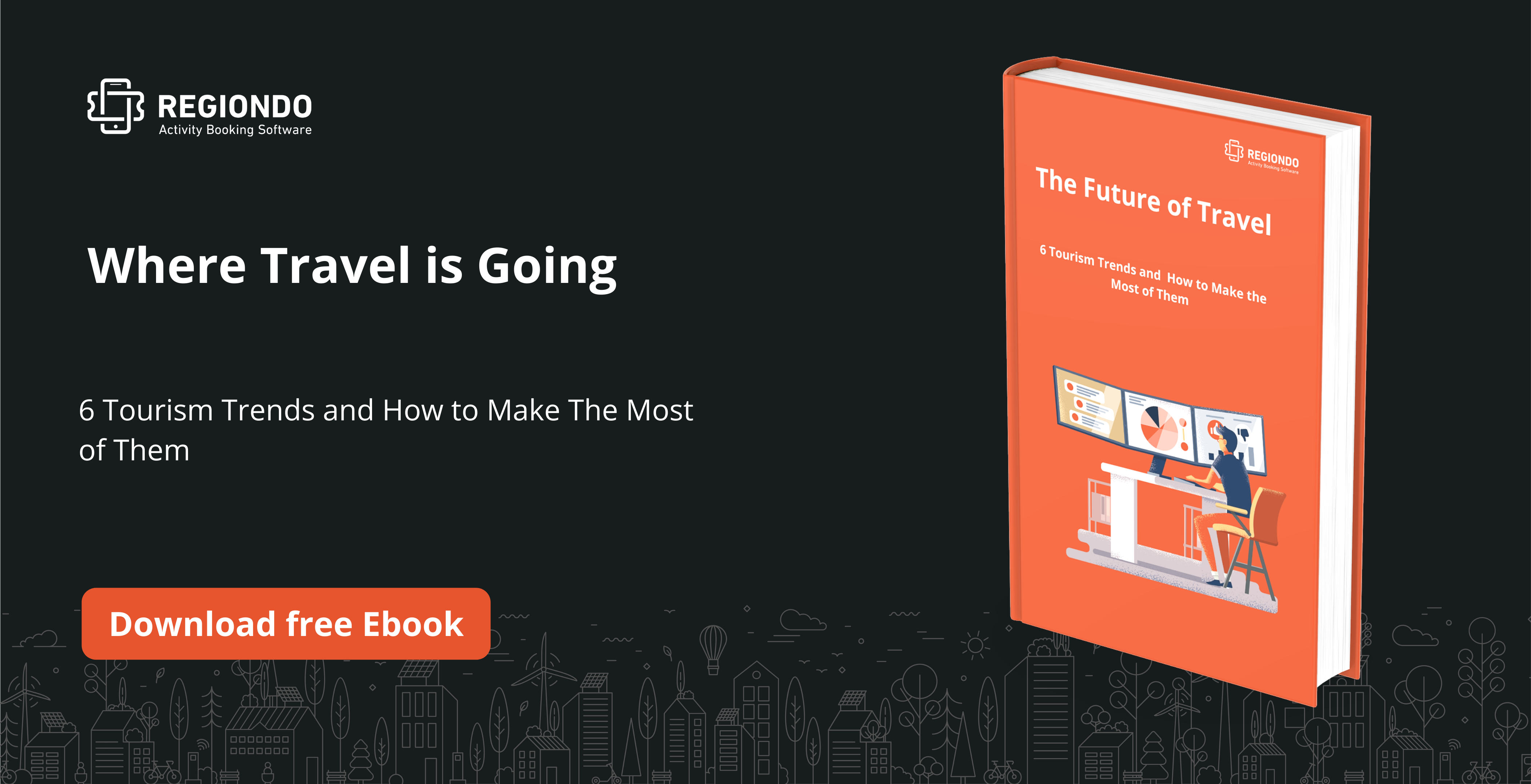
Bleisure travel is a growing tourism trend where people extend their business travel to leisure activities. Experts predict it will continue to grow in the mobile workforce. Although business travel has started to make its comeback in 2021, bleisure is believed to be its future.
A 2018 study revealed that 60% of U.S. business trips incorporated leisure elements, an increase from 43% in 2016.
These business-leisure trips can either be pre-planned, whereby clients schedule their vacation within the same period of a job-related trip. Companies may also offer their workers some tourist experiences during work trips.
On the other hand, this can come as an afterthought. Once the meetings, professional conferences, and other work engagements are over, business travelers may decide to extend their stay and explore their destination.
There is also a growing trend among millennials known as the “digital nomad” phenomenon. This is whereby online workers and freelancers adopt the lifestyle of traveling as they work.
As a tour operator, you can take advantage of this growing trend by creating offers that entice business travelers to extend their stay for leisure. For example, you can sell team retreat packages combined with perks like photos, videos, and transportation.
Having wifi and chargers in buses and accommodation (for multi-day tours) can also entice digital nomads and other travelers looking to stay connected for work.
Gone are the days when booking a trip required clients to make a phone call, speak directly to a service provider, or walk into the supplier’s office for face-to-face negotiation.
Digitization has led to a rise in online bookings. Not only has this made advertising cheaper for travel companies , but also customers are enjoying and increasingly prefer the convenience it offers.
Tour and activities companies have also progressively adopted technology and online booking. In 2019, 71% of operators surveyed were using reservation technology in their businesses, a marked increase from just 25% in 2010. More to that, these companies experienced faster growth plus higher profitability.
Booking systems help tour & activity providers automate their processes and be more effective by adopting cutting-edge technologies. Long gone are the days when you are using spreadsheets, pen and paper to manage your reservations: booking systems do it all automatically, save your time and money. For example, Regiondo booking system has won European travel market by providing seamless reservation experience, flexibility and innovations to businesses of any size.

As we approach the post-COVID period, automation in the sector is bound to continue rising. The increasing digitalization of tourism also generates new business opportunities and promotes the sustainable development of the sector. So as you work on getting back to profitability, take advantage of this tourism trend, and set up the right technology in order to increase your chances of faster recovery.
Another important aspect when it comes to digitization is mobile bookings .
Operators report that 2 in 5 online bookings are made on mobile devices. These smartphone shoppers are also more valuable to your business because of the following reasons:
- They spend 50% more on tours and activities per trip.
- They average 2.9 tours per trip.
- They are twice as likely to leave online reviews .
Source: Arival Travel
According to Think with Google , 57% of travelers believe that companies should personalize their buying experience and base it on their behaviors, personal preferences, and past choices.
Personalization is also important when it comes to the actual tour or activity. By offering flexible experiences that can be tailored to a traveler’s needs, you stand a chance of better satisfying your clients, and that can lead to repeat visits. Your priority should, therefore, be on offering customer-oriented services.
It starts right from the time they see your advert on social media or your website. The messaging should resonate with what the client prefers. Travel and tour suggestions can be offered according to, for instance, what the customer has been browsing on the internet. This is possible to set up using specialized marketing tools and ad platforms like Google and Facebook.
You are better placed by factoring this into your company’s digital marketing strategy. How do you get started? Reach out and speak to your customers to learn about their preferences , characteristics, behavior, and individual needs.
All in all, staying on top of this tourism trend can be the distinction that will make your company stand out from competitors and gain back profitability faster.
We already talked about automation and mobile bookings as some of the future trends in the tourism sector. But existing and emerging technologies will continue to influence travel in many other ways.
A recent Amadeus survey states that technology and innovation seem to be key in building traveler confidence and they will increase willingness to travel in the next 12 months.
Technologies proved to be crucial in the post-pandemic world where international tourists need to present Digital COVID Certificates or fill out travel documentation. What is more, people need instant access to information and help when being abroad.
In the coming year, tech innovations will continue to bring ease to the travel experience. The top five technologies that would increase confidence to travel in the next 12 months are:
- Mobile applications that provide on-trip notifications and alerts (44%)
- Self-service check-in (41%)
- Contactless mobile payments, e.g., Apple Pay (41%)
- Automated and flexible cancellation policies (40%)
- Mobile boarding (40%)
In addition to supporting people throughout their journey, technologies made innovative solutions possible. Virtual tours, experiences, and classes gained significant popularity during the lockdowns, and thanks to tech innovation, many businesses survived the crisis.
The first step for technology-empowered travel experience is a website. However, to make sure your customers can easily find you in the search engines, it is important to care about your SEO metrics. Try our free SEO Grader tool to learn how your website performs and get free recommendations on how you can improve it.

Following the COP 26 UN Climate Change Conference and the launch of The Glasgow Declaration on Climate Action , countries are urged to accelerate climate action in tourism. So encouraging sustainable tourism practices and environmental initiatives is of utmost importance for the resilience of the sector.
The UNWTO Secretary-general has warned that the “climate emergency is a bigger threat than Covid”. As international travelers become aware of this crisis, they come to believe that people need to take action now and make sustainable travel choices in order to save the planet and preserve it for future generations.
More travelers are adopting this mindset hence making their travel decisions with the environment in mind.
But it’s important to note that sustainability is not only about the environment. It’s also about making a positive impact on cultures, economies, and the people at the destinations that clients visit.
In the post-COVID-19 era, sustainability will be a continuous trend in travel and tourism. If you play your part in upholding sustainability, you can earn the trust and loyalty of the generation of travelers who are spearheading this trend.
Active Ecotourism is another trend that has emerged in response to the calls for more sustainable and thoughtful tourism. It encourages combining the passion for travel with direct involvement in conservation and supporting the local environment.
According to a recent Amadeus survey on rebuilding travel, people consider cost-effective sustainable travel a priority.
37% of travelers surveyed think opportunities for travelers to be involved in the preservation of tourist destinations will help the industry to become more sustainable in the long term.
According to Evolve’s 2022 travel forecasts , 58% of people will be more interested in exploring the outdoors and practicing relevant activities including hiking, biking , and kayaking . Mountain/rural escapes and waterfront getaways are expected to be popular vacation experiences in 2022.
Covid-19 has drawn our attention to the negative impact of travel on the global environment and initiated a promise for ‘coming back better’. So the tourism industry will continue this trend by promoting sustainable outdoor travel and ecotourism in the post-pandemic era.
This is a new tourism trend that’s quickly gaining popularity. Transformative travel is about not just traveling for leisure but also aiming to make a difference in both the lives of others and oneself.
Volunteering trips are an example of the experiences that have gained popularity from this trend. Travelers vacation and also set aside time to volunteer at their travel destinations.
When it comes to making a difference in their own lives, clients can opt to go for wellness holidays where they retreat and either join a yoga class, relax at a nature-filled destination, or attend some apprenticeship classes to learn a new skill.
Because of this trend, there is also a notable change in the travelers’ diet. Instead of indulging in unhealthy meals, those who’ve joined the organic food movement prefer places that offer highly nutritious and organic foods.
One of the main aims of transformative travel is to be involved in something that’s significant and adds purpose to the trip. Booking.com shares that 68% of global travelers would consider participating in cultural exchanges to learn a new skill, followed by a volunteering trip (54%) and international work placements (52%).
Based on this trend, tour operators can focus on offering unique and purposeful activities along with their usual products and services.
Experience tourism is on the rise . This trend is about having a once-in-a-lifetime experience or gaining an emotional connection with cultures and nature.
As travelers get tired or bored of cookie-cutter vacations in touristy hot spots, they begin looking for an authentic experience in their travel destination. They can easily go for a brand that will allow them to mingle with the locals and experience the culture of the people.
Harris Group did a study that revealed that 72% of millennials prefer spending more money on unique experiences rather than on material things.
So, if you can offer these experiences, then you’re well on your way to acquiring this increasing breed of clients. One of the most popular experiences is food sampling. Food tourism enables travelers to enjoy different local cuisines, maybe even learn how to cook some of the recipes, and interact with the people’s traditions in the process.
Another way clients want to experience their destinations is by staying with local families rather than in hotels. This gives them a chance to interact even closer with the locals and see their way of life.
These are travelers looking for an enriching experience with the primary purpose of achieving, promoting, or maintaining the best health and sense of well-being and balance in life.
But don’t think wellness travel is limited to resorts and spas. Almost any business can take advantage of this trend.
Think of how you can market your business offers as a way to contribute to wellness tourism by developing and promoting communities and showing how both tourists and locals can benefit.
For example, a helicopter tour, paragliding flight, or whatever fun adventure your company offers, is a chance for personal growth by conquering fears or expanding horizons. Your existing offers may give the chance for people to empower themselves by learning a new skill set which also encourages personal growth.
With international travel returning to some degree, tourists are starting to dream about extended long-distance trips again. While countries are advocating for less air travel, this trend will allow people to travel less but better.
According to Evolve’s 2022 travel forecasts , the average trip will likely be longer in length (5-7 nights in 2022, compared to an average of 3.8 nights in both 2020 and 2021).
Longer trips will be increasing in demand as a result of the many work-from-home opportunities too. A study by Envoy finds that the hybrid work model gives employees more flexibility to get work done when they’re most productive.
So those who work remotely are more likely to plan extended stays in 2022 and beyond.
Staycation is another trend that gained popularity during the pandemic. It represents a holiday spent in one’s home country or home rather than abroad. Often involves day trips for exploring local attractions and activities. This type of vacation is ideal for people who are feeling the need of escaping out of their homes but want to avoid the ongoing Covid-19 regulations.
New research suggests that the trend will continue into 2022 despite the easing of international travel restrictions. This is because tourists want to support their local markets well as feel secure and safe in their holiday environment.
So small tour/activity businesses and accommodation providers can rest assured that there will be a constant stream of visitors during the years to come.
As a tour operator or DMO, it’s best to keep an eye on these tourism trends and begin strategizing. These include:
- The merging of business and leisure travels
- Increasing automation
- Mobile bookings
- Personalization of trips
- Tech-Empowered Travel
- Active ecotourism
- A focus on sustainable tourism
- Transformative travel
- Experience tourism
- Wellness travel
- Longer trips
- Staycations
Have a plan of how to meet the needs of your clients and take advantage of these trends. This can be the much-needed headstart to help you emerge above your competition as you seek to recover from the consequences of the pandemic.
You might also like:
- The Rise of Bleisure Travel and How to Make the Most of it
- Travel Like a Local: How Tour Operators Can Make the Most of This Trend
- Health Tourism in the EU: Facts and Figures
- Virtual Reality in Travel: 9 Applications for Tours, Destinations & Activities
- The Rise of Solo Travel and How to Make the Most of it
- When Numbers Matter: The Travel Statistics You Need to Know About
- The Rise of Experience Tourism and What It Means for the Leisure Industry
Related Articles
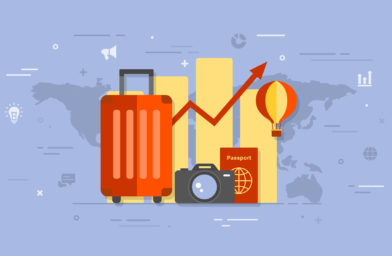
- Tips & tricks
- Trends 2024
Stay updated with Regiondo by signing up for our Newsletter

Get a personalized demo or create your free account now
Take your business to the next level with Regiondo - it's free to get started and you don't need a credit card.
Numbers, Facts and Trends Shaping Your World
Read our research on:
Full Topic List
Regions & Countries
- Publications
- Our Methods
- Short Reads
- Tools & Resources
Read Our Research On:
5 facts about presidential travel abroad
American presidents and other world leaders frequently travel internationally, most commonly for conferences and bilateral meetings. This face-to-face diplomacy can offer insights into political priorities, partnerships and tensions, as well as key international issues.
The COVID-19 pandemic disrupted international travel in 2020 and 2021, but diplomatic travel picked up significantly in 2022. Here are five facts about presidential travel abroad:
Pew Research Center conducted this analysis to examine the international travel history of recent U.S. presidents and other heads of government through Jan. 20, 2023.
Dates and destinations of U.S. presidential travel prior to 2021 are from the U.S. Department of State’s Office of the Historian, which has recorded international presidential travel since 1901. Travel data for 2021 and 2022 was compiled from White House press briefings. Information on visits to Ukraine by other world leaders were independently verified through official government websites.
Only trips where the head of government met face-to-face with another head of government are included. For example, Biden’s trip to the UK for Queen Elizabeth II’s funeral is excluded as Biden did not hold any diplomatic meetings with the British prime minister or other world leaders. Visiting leaders were only counted if they were the head of government at the time of their visit. Depending on the country’s political system, “head of government” could mean president or prime minister, but not both. Heads of state, monarchs and interim leaders are excluded from the visiting leaders count.
U.S. President Joe Biden has traveled internationally less frequently than his last two predecessors did. Biden traveled to 17 places outside the United States in his first two years in office, visiting some more than once. He made six international trips in 2021, all of them to Europe. In 2022, he made 12 trips, including to Europe, the Asia-Pacific region and the Middle East. And in early 2023, Biden traveled to Mexico for the North American Leaders’ Summit.
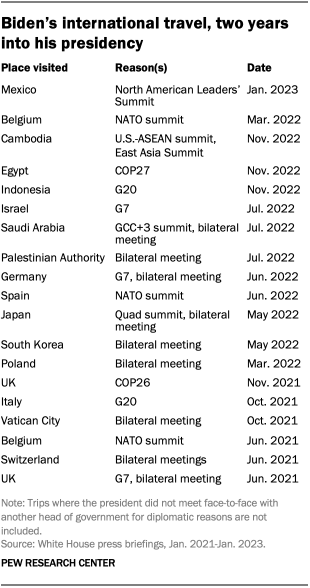
All told, Biden’s international visit count trails those of former Presidents Donald Trump, who made 23 international trips to 20 places during his first two years in office, and Barack Obama, who made 32 trips to 24 places in the first two years of his presidency.
Biden’s first presidential trip abroad was to the United Kingdom, while Trump’s was to Saudi Arabia and Obama’s was to Canada. A president’s first trip is often used to signal the importance of a strategic alliance. On his trip to the UK in June 2021, Biden reaffirmed the U.S.-UK partnership and committed to close cooperation throughout his presidency. Typically, U.S. presidents visit a close ally on their inaugural trip: Canada was the first international destination for both Obama and Bill Clinton, while Mexico was the first destination for George W. Bush.
U.S. presidents have visited the UK the most in the past decade – a total of eight times. American presidents have worked closely with their British counterparts over the past decade, cooperating on issues from defense and counterterrorism to climate policy . Travel to the UK has largely centered around conferences and summits, but in 2019, Trump made a ceremonial state visit to the UK .
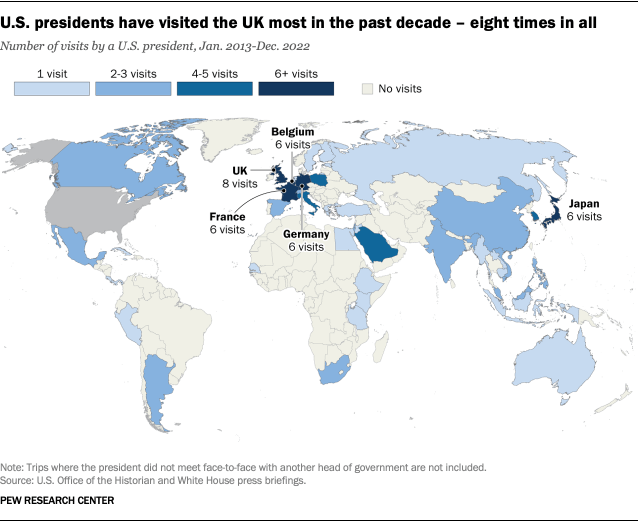
In the past decade of presidential travel, Belgium (home to NATO headquarters ), France, Germany and Japan are the second-most visited destinations, at six times each.
So far, Biden has made the most trips to the UK and Belgium – two each. (Biden’s additional visit to the UK to attend the funeral of Queen Elizabeth II is not included in this count, since he did not hold any diplomatic appointments.) Just as these two European allies stand out in Biden’s presidential travel thus far, France stands out in Trump’s administration and Germany stands out in Obama’s – they visited those respective countries four times while in office.
Biden is among 38 heads of government who have visited Ukraine since the beginning of the war there. Biden traveled to Kyiv as part of a surprise trip in February, days before the first anniversary of Russia’s invasion .
While many heads of government visiting Ukraine have come from neighboring countries or countries in Europe (such as Poland’s prime minister, who has visited five times since the beginning of the war) that is not always the case. For example, Guatemala’s President Alejandro Giammattei and Guinea-Bissau’s President Umaro Sissoco Embaló traveled to Ukraine in July 2022 and October 2022, respectively.
Biden hosted 28 heads of government at the White House as of the end of 2022. Foreign leaders come to the U.S. for events including conferences, summits and bilateral meetings. Among those to visit the White House in 2021 and 2022 were then-Prime Minister Magdalena Andersson of Sweden, who met with Biden to submit her country’s application for NATO membership ; Ukrainian President Volodymyr Zelenskyy, who traveled to the White House on his first known wartime trip abroad ; and French President Emmanuel Macron, whose trip marked the first state visit of Biden’s presidency . In fact, the president of France has been the first leader to make a state visit to the U.S. for the past three presidential terms, with Macron visiting Trump in April 2018 and his predecessor, François Hollande, visiting Obama in February 2014. In April 2023, Biden hosted the second state visit of his administration , meeting with South Korean President Yoon Suk Yeol.
- International Affairs

Sarah Austin is a research assistant focusing on global attitudes research at Pew Research Center
A growing share of Americans have little or no confidence in Netanyahu
Fewer americans view the united nations favorably than in 2023, what are americans’ top foreign policy priorities, rising numbers of americans say jews and muslims face a lot of discrimination, younger americans stand out in their views of the israel-hamas war, most popular.
1615 L St. NW, Suite 800 Washington, DC 20036 USA (+1) 202-419-4300 | Main (+1) 202-857-8562 | Fax (+1) 202-419-4372 | Media Inquiries
Research Topics
- Age & Generations
- Coronavirus (COVID-19)
- Economy & Work
- Family & Relationships
- Gender & LGBTQ
- Immigration & Migration
- Internet & Technology
- Methodological Research
- News Habits & Media
- Non-U.S. Governments
- Other Topics
- Politics & Policy
- Race & Ethnicity
- Email Newsletters
ABOUT PEW RESEARCH CENTER Pew Research Center is a nonpartisan fact tank that informs the public about the issues, attitudes and trends shaping the world. It conducts public opinion polling, demographic research, media content analysis and other empirical social science research. Pew Research Center does not take policy positions. It is a subsidiary of The Pew Charitable Trusts .
Copyright 2024 Pew Research Center
Terms & Conditions
Privacy Policy
Cookie Settings
Reprints, Permissions & Use Policy

IMAGES
COMMENTS
171. Ana Miminoshvili. By The New York Times. Published Feb. 15, 2022 Updated March 8, 2022. As governments across the world loosen coronavirus restrictions and shift their approach to accepting ...
In 2020 alone, the travel and tourism sector lost $4.5 trillion and 62 million jobs globally. But as the world recovers from the impacts of the COVID-19 pandemic, travel and tourism can bounce back as an inclusive, sustainable, and resilient sector. Two experts highlight some of the key transformations in the sector going forward during the ...
Outlook for 2022. According to the latest UNWTO Panel of Experts, most tourism professionals (61%) see better prospects for 2022. While 58% expect a rebound in 2022, mostly during the third quarter, 42% point to a potential rebound only in 2023. A majority of experts (64%) now expect international arrivals to return to 2019 levels only in 2024 ...
NEEDHAM, Mass., January 12, 2022 - A new travel trends research paper released today by Tripadvisor®, the world's largest travel guidance platform*, in partnership with Ipsos MORI, reveals how respondents are planning to travel in 2022 and beyond, and how their attitudes and behaviors in relation to travel have changed as compared to pre-pandemic.
According to the latest UNWTO World Tourism Barometer, international tourist arrivals almost tripled in January to July 2022 (+172%) compared to the same period of 2021. This means t he sector recovered almost 60% of pre-pandemic levels. The steady recovery reflects strong pent-up demand for international travel as well as the easing or lifting ...
In Hilton's new travel trends report, 'The 2022 Traveler: Emerging Trends and the Redefined Traveler', the hotel brand looks at the impact that Covid has had on travel. The report highlights ...
KIDS RULE OK. One leading trend identified in the 2022 Trend Report from holiday rentals community brand Vrbo is a renewed focus on family travel . Dive into family adventures with Vrbo. "Over ...
The GOAT mindset: Expedia reveals 2022's biggest travel trends. Travelers are ready to shake up the status quo, according to Expedia's 2022 Travel Trends Report. Top findings from the report, which leverage Expedia data and a global research study, revealed that more than two-thirds of Americans (68 percent) plan to go big on their next trip.
The Pandemic Shapes More New Travel Trends 1/11. Could 2022 be bigger than 2019 when it comes to travel? After two years of being plagued by COVID-19 travel restrictions and postponed trips, Americans are ready for a vacation. The pandemic has, however, transformed the way people think about travel, what they expect on vacation and how they ...
Insight Vacations has seen a 10% increase in bookings on tours that are two weeks or longer. While Italy is the most popular destination for single-destination trips in 2022 for Insight Vacations and Luxury Gold, the brands have noticed a 40% increase for domestic travel in the U.S. as well as a 15% increase in single-destination bookings for ...
While the global wellness tourism market fell from $720.4 billion to $435.7 billion—a whopping 39.5%—between 2019 and 2020, it's bouncing back with astonishing gusto.
It is difficult to make an estimate for 2022 as it is not known how the pandemic will evolve. However, it is possible to talk about the new tourism trends that are likely to emerge over the coming year: - International travel with restrictions still maintained by both destinations and airlines in order to offer 100% security to the consumer.
Tourism Enjoys Strong Start to 2022 while Facing New Uncertainties. All Regions. 25 Mar 2022. International tourism continued its recovery in January 2022, with a much better performance compared to the weak start to 2021. However, the Russian invasion of Ukraine adds pressure to existing economic uncertainties, coupled with many Covid-related ...
Notable travel trends in 2022. 1. People's awareness of health and safety has increased. Image credit: Erik Odiin. When travelling nowadays, there's definitely an increase in health and safety awareness among travellers. People are more concerned and aware of their surroundings, as the pandemic has taught us to take safety measures, such as ...
The pandemic has brought many changes to the travel industry and new trends are emerging. Here are some of our predictions for 2022. Image: totalpics/Zonar/picture alliance
The biggest travel trends for 2024. From gig tripping to home swapping, these are the trends shaping travel in 2024. By Sarah Allard. 18 December 2023. Milagros Pico. If 2022 was all about a return to travel, then 2023 was the year we went further than ever before. Travellers took to the skies, rails, roads and seas to tick off major bucket ...
Trend 1: Community tourism is the solution to responsible travel. According to G Adventures' latest panel research, close to a third (28 per cent*) of respondents say they will place more focus on travelling responsibly in 2022. With the increased focus on community and support of locally owned businesses fostered during the pandemic, it ...
2022 has been the year to rethink tourism. Countries around the world turned UNWTO's vision for a greener, smarter and more inclusive sector into real action. 2020 showed the relevance of tourism for sustainable development. 2021 laid the foundations for the transformation of the sector. In 2022, we made it happen. 2022 began on a positive note.
This was a decrease of 24%. There were 12.1 million holiday visits to the UK in 2022, which were 39% of the total visits. This makes holidays the most common reason for visiting the UK. This is a change from 2021 when visiting friends or relatives was the most popular reason for travel to the UK.
NEEDHAM, Mass., Jan. 11, 2022 /PRNewswire/ -- A new travel trends research paper released today by Tripadvisor ®, the world's largest travel guidance platform*, in partnership with Ipsos MORI, reveals how consumers are planning to travel in 2022 and beyond, and how their attitudes and behaviors in relation to travel have changed as compared to pre-pandemic.
Travel fell sharply during the COVID-19 pandemic—airline revenues dropped by 60 percent in 2020, and air travel and tourism are not expected to return to 2019 levels before 2024. 1 "Back to the future? Airline sector poised for change post-COVID-19," McKinsey, April 2, 2021; "What will it take to go from 'travel shock' to surge? " McKinsey, November 23, 2021.
10. Wellness Travel. 11. Longer Trips. 12. Staycation. Conclusion. With travelers' desire for new experiences, the rapid global technological advancements, climate change, and other dynamics, the travel and tourism industry is constantly transforming. Having experienced an all-time high in the past decade, with 2018 recording the highest ...
Slow travel is already taking off, and we expect the acceleration of the slow travel movement to be one of the defining trends of 2022.". Immersive experiences are part of this trend and when it ...
approximately $713 billion in 202 1, up 4% from 2020 but is still 61% below 2019 levels. In ternational tourism r eceipts reached. $602 billion, which is also 4% more in real terms than in 2020 ...
Dates and destinations of U.S. presidential travel prior to 2021 are from the U.S. Department of State's Office of the Historian, which has recorded international presidential travel since 1901. Travel data for 2021 and 2022 was compiled from White House press briefings.